Property Law: BSBLEG512 - Apply Legal Principles Assignment
VerifiedAdded on 2022/10/09
|14
|7841
|32
Homework Assignment
AI Summary
This assignment focuses on property law, specifically within the context of Queensland, Australia. The provided document includes a completed general tenancy agreement (Form 18a) under the Residential Tenancies and Rooming Accommodation Act 2008, detailing tenancy specifics such as lessor and tenant information, addresses, agent details, and the term of the agreement. It covers rent payment terms, bond amounts, services supplied, and the number of permitted residents. Additionally, it references standard terms and clauses related to the start of tenancy, condition reports, continuation of fixed-term agreements, costs associated with early termination, rent payment procedures, rent increases, and applications to tribunals. The assignment also includes excerpts from a real estate contract for houses and residential land, and coversheets for legal matters, demonstrating a practical application of legal principles in property law.
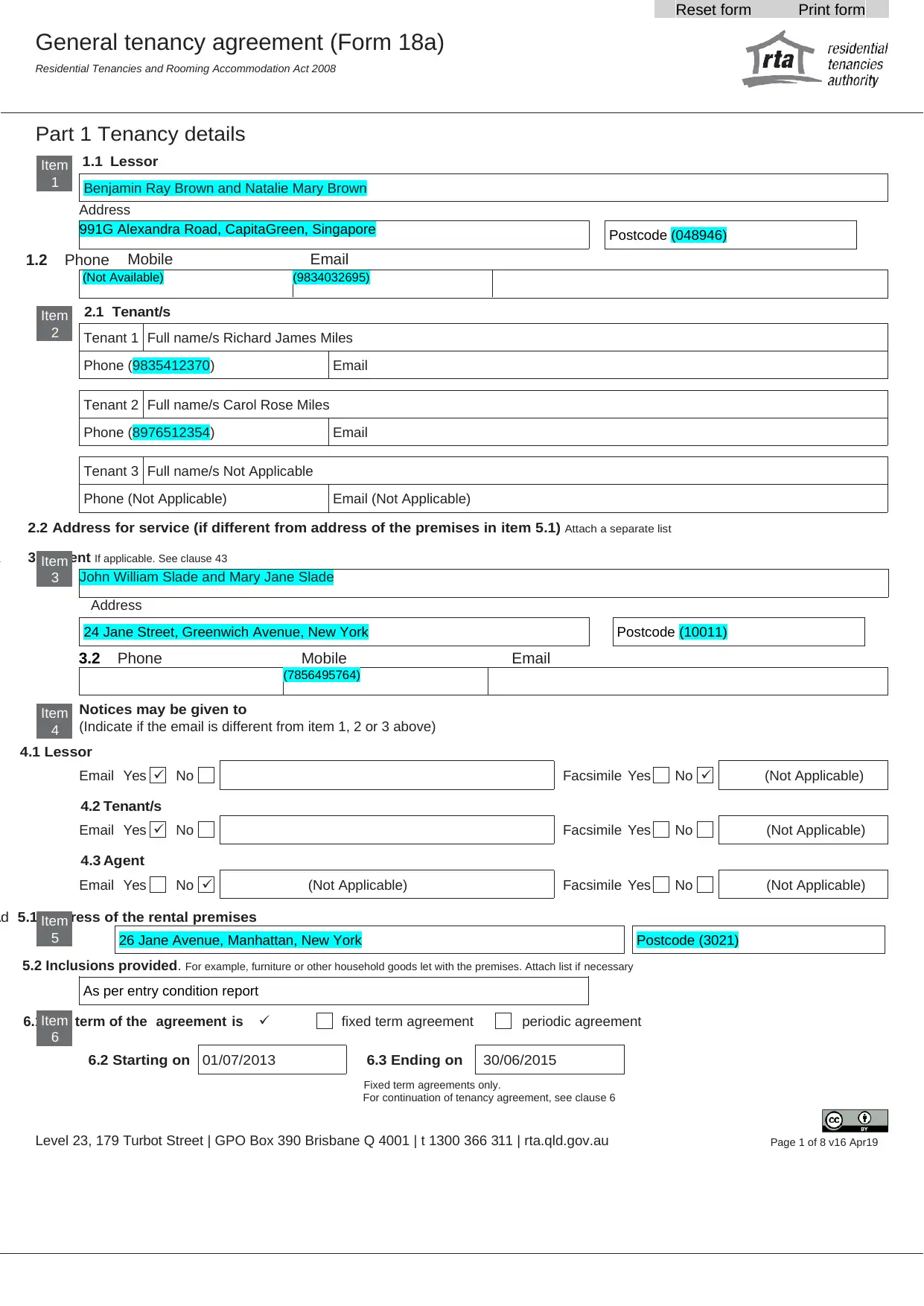
Benjamin Ray Brown and Natalie Mary Brown
John William Slade and Mary Jane Slade
Reset form Print form
General tenancy agreement (Form 18a)
Residential Tenancies and Rooming Accommodation Act 2008
Part 1 Tenancy details
1.1 Lessor
Address
991G Alexandra Road, CapitaGreen, Singapore Postcode (048946)
1.2 Phone Mobile Email
(Not Available) (9834032695)
2.1 Tenant/s
Tenant 1 Full name/s Richard James Miles
Phone (9835412370) Email
Tenant 2 Full name/s Carol Rose Miles
Phone (8976512354) Email
Tenant 3 Full name/s Not Applicable
Phone (Not Applicable) Email (Not Applicable)
2.2 Address for service (if different from address of the premises in item 5.1) Attach a separate list
A 3.1 Agent If applicable. See clause 43
Address
24 Jane Street, Greenwich Avenue, New York Postcode (10011)
3.2 Phone Mobile Email
(7856495764)
Notices may be given to
(Indicate if the email is different from item 1, 2 or 3 above)
4.1 Lessor
Email Yes No Facsimile Yes No (Not Applicable)
4.2 Tenant/s
Email Yes No Facsimile Yes No (Not Applicable)
4.3 Agent
Email Yes No (Not Applicable) Facsimile Yes No (Not Applicable)
Ad 5.1 Address of the rental premises
26 Jane Avenue, Manhattan, New York Postcode (3021)
5.2 Inclusions provided. For example, furniture or other household goods let with the premises. Attach list if necessary
As per entry condition report
6.1 The term of the agreement is fixed term agreement periodic agreement
6.2 Starting on 01/07/2013 6.3 Ending on 30/06/2015
Fixed term agreements only.
For continuation of tenancy agreement, see clause 6
Level 23, 179 Turbot Street | GPO Box 390 Brisbane Q 4001 | t 1300 366 311 | rta.qld.gov.au Page 1 of 8 v16 Apr19
Item
6
Item
5
Item
4
Item
3
Item
2
Item
1
John William Slade and Mary Jane Slade
Reset form Print form
General tenancy agreement (Form 18a)
Residential Tenancies and Rooming Accommodation Act 2008
Part 1 Tenancy details
1.1 Lessor
Address
991G Alexandra Road, CapitaGreen, Singapore Postcode (048946)
1.2 Phone Mobile Email
(Not Available) (9834032695)
2.1 Tenant/s
Tenant 1 Full name/s Richard James Miles
Phone (9835412370) Email
Tenant 2 Full name/s Carol Rose Miles
Phone (8976512354) Email
Tenant 3 Full name/s Not Applicable
Phone (Not Applicable) Email (Not Applicable)
2.2 Address for service (if different from address of the premises in item 5.1) Attach a separate list
A 3.1 Agent If applicable. See clause 43
Address
24 Jane Street, Greenwich Avenue, New York Postcode (10011)
3.2 Phone Mobile Email
(7856495764)
Notices may be given to
(Indicate if the email is different from item 1, 2 or 3 above)
4.1 Lessor
Email Yes No Facsimile Yes No (Not Applicable)
4.2 Tenant/s
Email Yes No Facsimile Yes No (Not Applicable)
4.3 Agent
Email Yes No (Not Applicable) Facsimile Yes No (Not Applicable)
Ad 5.1 Address of the rental premises
26 Jane Avenue, Manhattan, New York Postcode (3021)
5.2 Inclusions provided. For example, furniture or other household goods let with the premises. Attach list if necessary
As per entry condition report
6.1 The term of the agreement is fixed term agreement periodic agreement
6.2 Starting on 01/07/2013 6.3 Ending on 30/06/2015
Fixed term agreements only.
For continuation of tenancy agreement, see clause 6
Level 23, 179 Turbot Street | GPO Box 390 Brisbane Q 4001 | t 1300 366 311 | rta.qld.gov.au Page 1 of 8 v16 Apr19
Item
6
Item
5
Item
4
Item
3
Item
2
Item
1
Secure Best Marks with AI Grader
Need help grading? Try our AI Grader for instant feedback on your assignments.
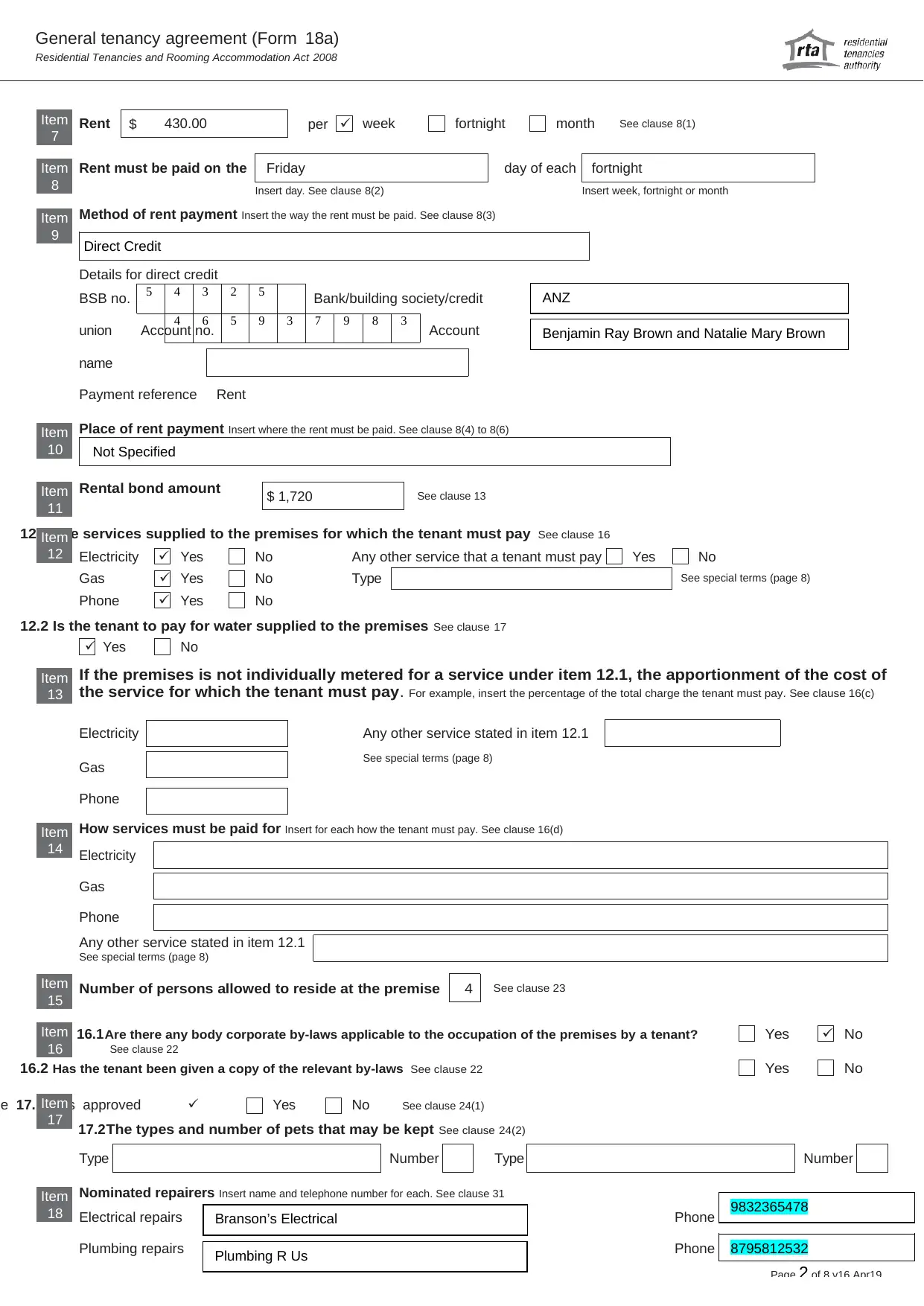
General tenancy agreement (Form 18a)
Residential Tenancies and Rooming Accommodation Act 2008
Page 2 of 8 v16 Apr19
$Rent 430.00 per week fortnight month See clause 8(1)
Rent must be paid on the Friday day of each fortnight
Insert day. See clause 8(2) Insert week, fortnight or month
Method of rent payment Insert the way the rent must be paid. See clause 8(3)
Direct Credit
Details for direct credit
BSB no. Bank/building society/credit
union Account no. Account
name
Payment reference Rent
Place of rent payment Insert where the rent must be paid. See clause 8(4) to 8(6)
Not Specified
Rental bond amount See clause 13
12.1 The services supplied to the premises for which the tenant must pay See clause 16
Electricity Yes No Any other service that a tenant must pay Yes No
Gas Yes No Type See special terms (page 8)
Phone Yes No
12.2 Is the tenant to pay for water supplied to the premises See clause 17
Yes No
If the premises is not individually metered for a service under item 12.1, the apportionment of the cost of
the service for which the tenant must pay. For example, insert the percentage of the total charge the tenant must pay. See clause 16(c)
Electricity Any other service stated in item 12.1
Gas See special terms (page 8)
Phone
How services must be paid for Insert for each how the tenant must pay. See clause 16(d)
Electricity
Gas
Phone
Any other service stated in item 12.1
See special terms (page 8)
Number of persons allowed to reside at the premise 4 See clause 23
16.1 Are there any body corporate by-laws applicable to the occupation of the premises by a tenant? Yes No
See clause 22
16.2 Has the tenant been given a copy of the relevant by-laws See clause 22 Yes No
Pe 17.1 Pets approved Yes No See clause 24(1)
17.2 The types and number of pets that may be kept See clause 24(2)
Type Number Type Number
Nominated repairers Insert name and telephone number for each. See clause 31
Electrical repairs Phone
Plumbing repairs Phone
Item
18
Item
17
Item
16
Item
15
Item
14
Item
13
Item
12
$ 1,720Item
11
Item
10
Item
9
Item
8
Item
7
5 4 3 2 5
4 6 5 9 3 7 9 8 3
Branson’s Electrical
Plumbing R Us
9832365478
8795812532
ANZ
Benjamin Ray Brown and Natalie Mary Brown
Residential Tenancies and Rooming Accommodation Act 2008
Page 2 of 8 v16 Apr19
$Rent 430.00 per week fortnight month See clause 8(1)
Rent must be paid on the Friday day of each fortnight
Insert day. See clause 8(2) Insert week, fortnight or month
Method of rent payment Insert the way the rent must be paid. See clause 8(3)
Direct Credit
Details for direct credit
BSB no. Bank/building society/credit
union Account no. Account
name
Payment reference Rent
Place of rent payment Insert where the rent must be paid. See clause 8(4) to 8(6)
Not Specified
Rental bond amount See clause 13
12.1 The services supplied to the premises for which the tenant must pay See clause 16
Electricity Yes No Any other service that a tenant must pay Yes No
Gas Yes No Type See special terms (page 8)
Phone Yes No
12.2 Is the tenant to pay for water supplied to the premises See clause 17
Yes No
If the premises is not individually metered for a service under item 12.1, the apportionment of the cost of
the service for which the tenant must pay. For example, insert the percentage of the total charge the tenant must pay. See clause 16(c)
Electricity Any other service stated in item 12.1
Gas See special terms (page 8)
Phone
How services must be paid for Insert for each how the tenant must pay. See clause 16(d)
Electricity
Gas
Phone
Any other service stated in item 12.1
See special terms (page 8)
Number of persons allowed to reside at the premise 4 See clause 23
16.1 Are there any body corporate by-laws applicable to the occupation of the premises by a tenant? Yes No
See clause 22
16.2 Has the tenant been given a copy of the relevant by-laws See clause 22 Yes No
Pe 17.1 Pets approved Yes No See clause 24(1)
17.2 The types and number of pets that may be kept See clause 24(2)
Type Number Type Number
Nominated repairers Insert name and telephone number for each. See clause 31
Electrical repairs Phone
Plumbing repairs Phone
Item
18
Item
17
Item
16
Item
15
Item
14
Item
13
Item
12
$ 1,720Item
11
Item
10
Item
9
Item
8
Item
7
5 4 3 2 5
4 6 5 9 3 7 9 8 3
Branson’s Electrical
Plumbing R Us
9832365478
8795812532
ANZ
Benjamin Ray Brown and Natalie Mary Brown
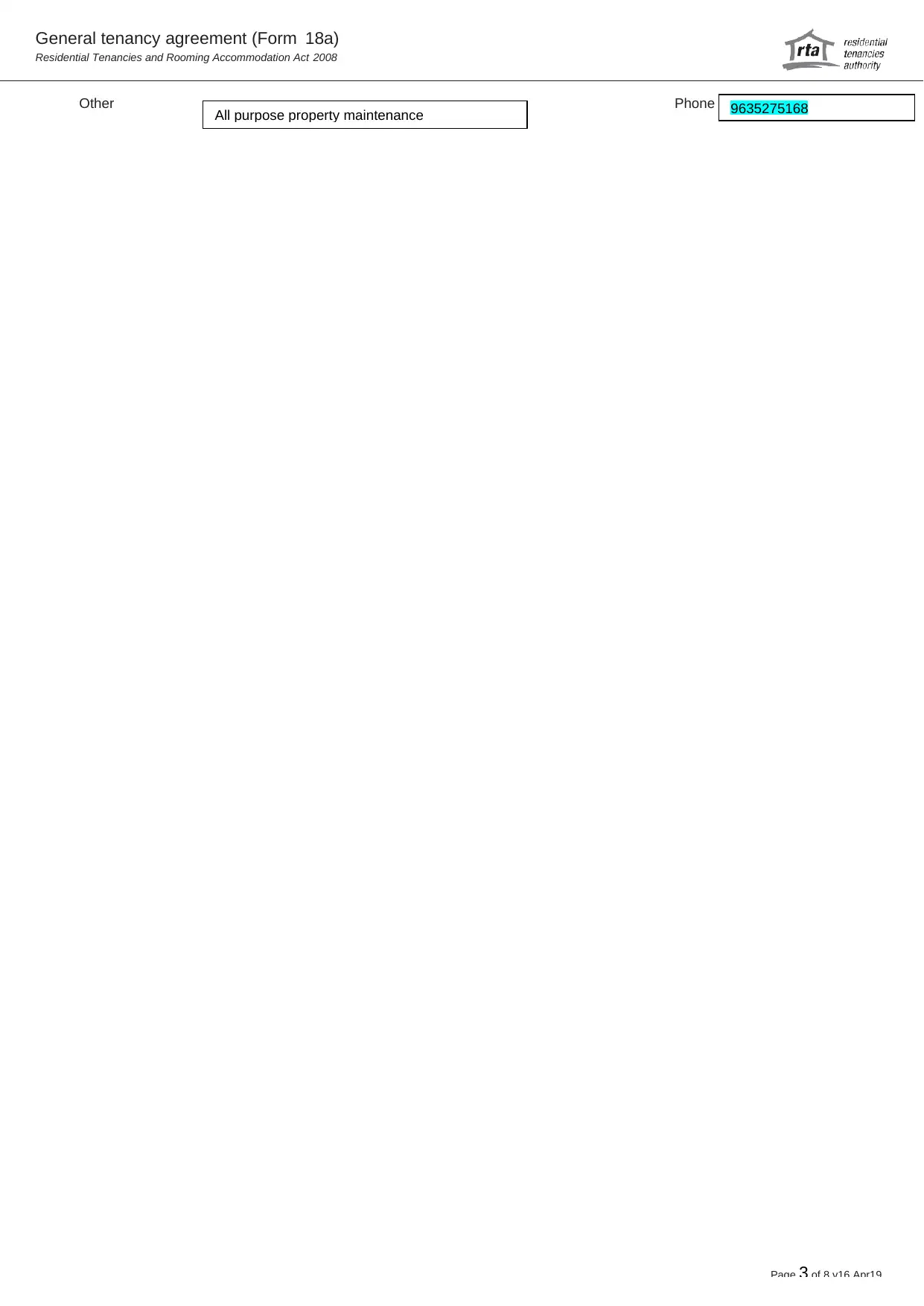
General tenancy agreement (Form 18a)
Residential Tenancies and Rooming Accommodation Act 2008
Page 3 of 8 v16 Apr19
Other Phone
All purpose property maintenance 9635275168
Residential Tenancies and Rooming Accommodation Act 2008
Page 3 of 8 v16 Apr19
Other Phone
All purpose property maintenance 9635275168
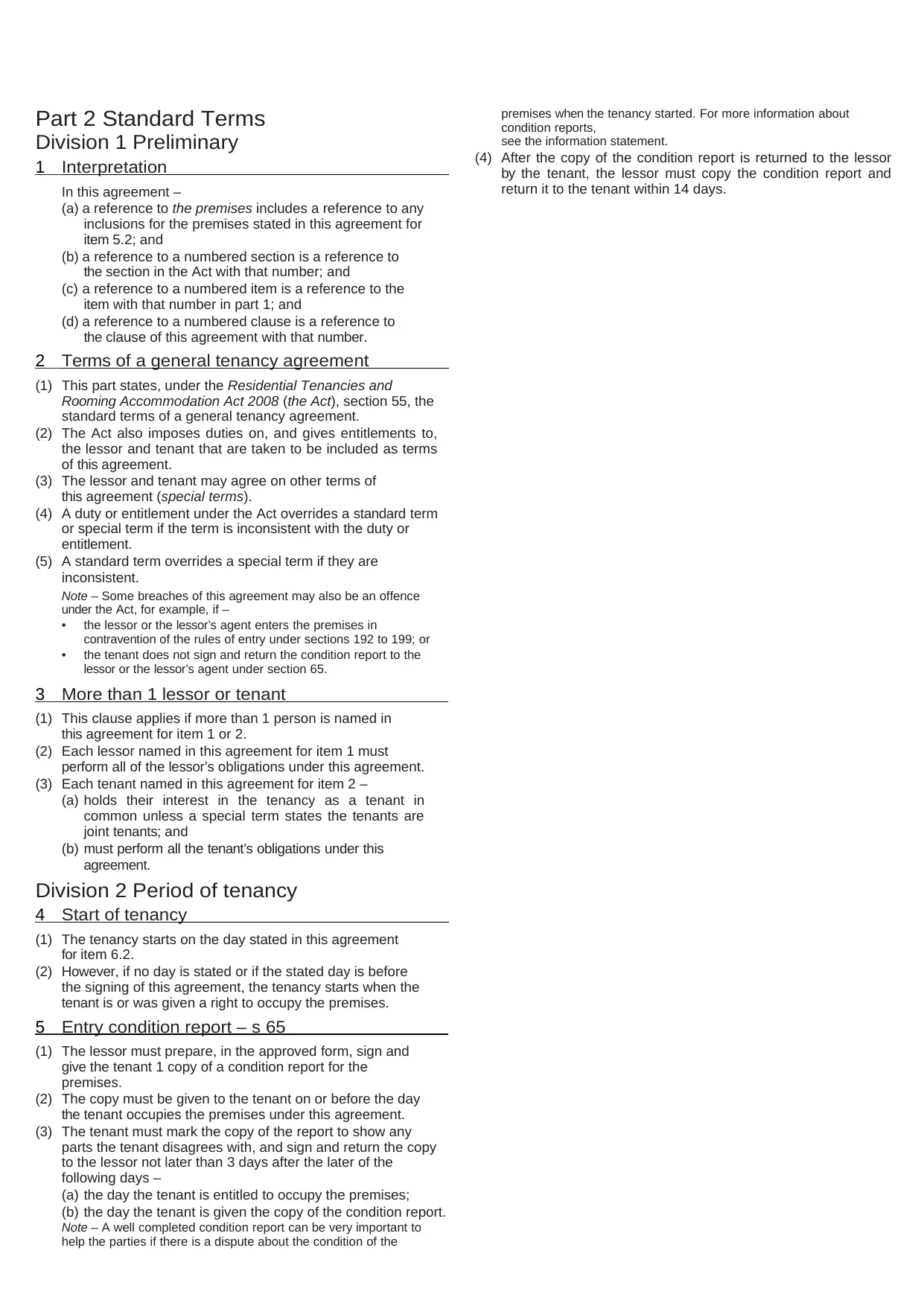
Part 2 Standard Terms
Division 1 Preliminary
1 Interpretation
In this agreement –
(a) a reference to the premises includes a reference to any
inclusions for the premises stated in this agreement for
item 5.2; and
(b) a reference to a numbered section is a reference to
the section in the Act with that number; and
(c) a reference to a numbered item is a reference to the
item with that number in part 1; and
(d) a reference to a numbered clause is a reference to
the clause of this agreement with that number.
2 Terms of a general tenancy agreement
(1) This part states, under the Residential Tenancies and
Rooming Accommodation Act 2008 (the Act), section 55, the
standard terms of a general tenancy agreement.
(2) The Act also imposes duties on, and gives entitlements to,
the lessor and tenant that are taken to be included as terms
of this agreement.
(3) The lessor and tenant may agree on other terms of
this agreement (special terms).
(4) A duty or entitlement under the Act overrides a standard term
or special term if the term is inconsistent with the duty or
entitlement.
(5) A standard term overrides a special term if they are
inconsistent.
Note – Some breaches of this agreement may also be an offence
under the Act, for example, if –
• the lessor or the lessor’s agent enters the premises in
contravention of the rules of entry under sections 192 to 199; or
• the tenant does not sign and return the condition report to the
lessor or the lessor’s agent under section 65.
3 More than 1 lessor or tenant
(1) This clause applies if more than 1 person is named in
this agreement for item 1 or 2.
(2) Each lessor named in this agreement for item 1 must
perform all of the lessor’s obligations under this agreement.
(3) Each tenant named in this agreement for item 2 –
(a) holds their interest in the tenancy as a tenant in
common unless a special term states the tenants are
joint tenants; and
(b) must perform all the tenant’s obligations under this
agreement.
Division 2 Period of tenancy
4 Start of tenancy
(1) The tenancy starts on the day stated in this agreement
for item 6.2.
(2) However, if no day is stated or if the stated day is before
the signing of this agreement, the tenancy starts when the
tenant is or was given a right to occupy the premises.
5 Entry condition report – s 65
(1) The lessor must prepare, in the approved form, sign and
give the tenant 1 copy of a condition report for the
premises.
(2) The copy must be given to the tenant on or before the day
the tenant occupies the premises under this agreement.
(3) The tenant must mark the copy of the report to show any
parts the tenant disagrees with, and sign and return the copy
to the lessor not later than 3 days after the later of the
following days –
(a) the day the tenant is entitled to occupy the premises;
(b) the day the tenant is given the copy of the condition report.
Note – A well completed condition report can be very important to
help the parties if there is a dispute about the condition of the
premises when the tenancy started. For more information about
condition reports,
see the information statement.
(4) After the copy of the condition report is returned to the lessor
by the tenant, the lessor must copy the condition report and
return it to the tenant within 14 days.
Division 1 Preliminary
1 Interpretation
In this agreement –
(a) a reference to the premises includes a reference to any
inclusions for the premises stated in this agreement for
item 5.2; and
(b) a reference to a numbered section is a reference to
the section in the Act with that number; and
(c) a reference to a numbered item is a reference to the
item with that number in part 1; and
(d) a reference to a numbered clause is a reference to
the clause of this agreement with that number.
2 Terms of a general tenancy agreement
(1) This part states, under the Residential Tenancies and
Rooming Accommodation Act 2008 (the Act), section 55, the
standard terms of a general tenancy agreement.
(2) The Act also imposes duties on, and gives entitlements to,
the lessor and tenant that are taken to be included as terms
of this agreement.
(3) The lessor and tenant may agree on other terms of
this agreement (special terms).
(4) A duty or entitlement under the Act overrides a standard term
or special term if the term is inconsistent with the duty or
entitlement.
(5) A standard term overrides a special term if they are
inconsistent.
Note – Some breaches of this agreement may also be an offence
under the Act, for example, if –
• the lessor or the lessor’s agent enters the premises in
contravention of the rules of entry under sections 192 to 199; or
• the tenant does not sign and return the condition report to the
lessor or the lessor’s agent under section 65.
3 More than 1 lessor or tenant
(1) This clause applies if more than 1 person is named in
this agreement for item 1 or 2.
(2) Each lessor named in this agreement for item 1 must
perform all of the lessor’s obligations under this agreement.
(3) Each tenant named in this agreement for item 2 –
(a) holds their interest in the tenancy as a tenant in
common unless a special term states the tenants are
joint tenants; and
(b) must perform all the tenant’s obligations under this
agreement.
Division 2 Period of tenancy
4 Start of tenancy
(1) The tenancy starts on the day stated in this agreement
for item 6.2.
(2) However, if no day is stated or if the stated day is before
the signing of this agreement, the tenancy starts when the
tenant is or was given a right to occupy the premises.
5 Entry condition report – s 65
(1) The lessor must prepare, in the approved form, sign and
give the tenant 1 copy of a condition report for the
premises.
(2) The copy must be given to the tenant on or before the day
the tenant occupies the premises under this agreement.
(3) The tenant must mark the copy of the report to show any
parts the tenant disagrees with, and sign and return the copy
to the lessor not later than 3 days after the later of the
following days –
(a) the day the tenant is entitled to occupy the premises;
(b) the day the tenant is given the copy of the condition report.
Note – A well completed condition report can be very important to
help the parties if there is a dispute about the condition of the
premises when the tenancy started. For more information about
condition reports,
see the information statement.
(4) After the copy of the condition report is returned to the lessor
by the tenant, the lessor must copy the condition report and
return it to the tenant within 14 days.
Secure Best Marks with AI Grader
Need help grading? Try our AI Grader for instant feedback on your assignments.
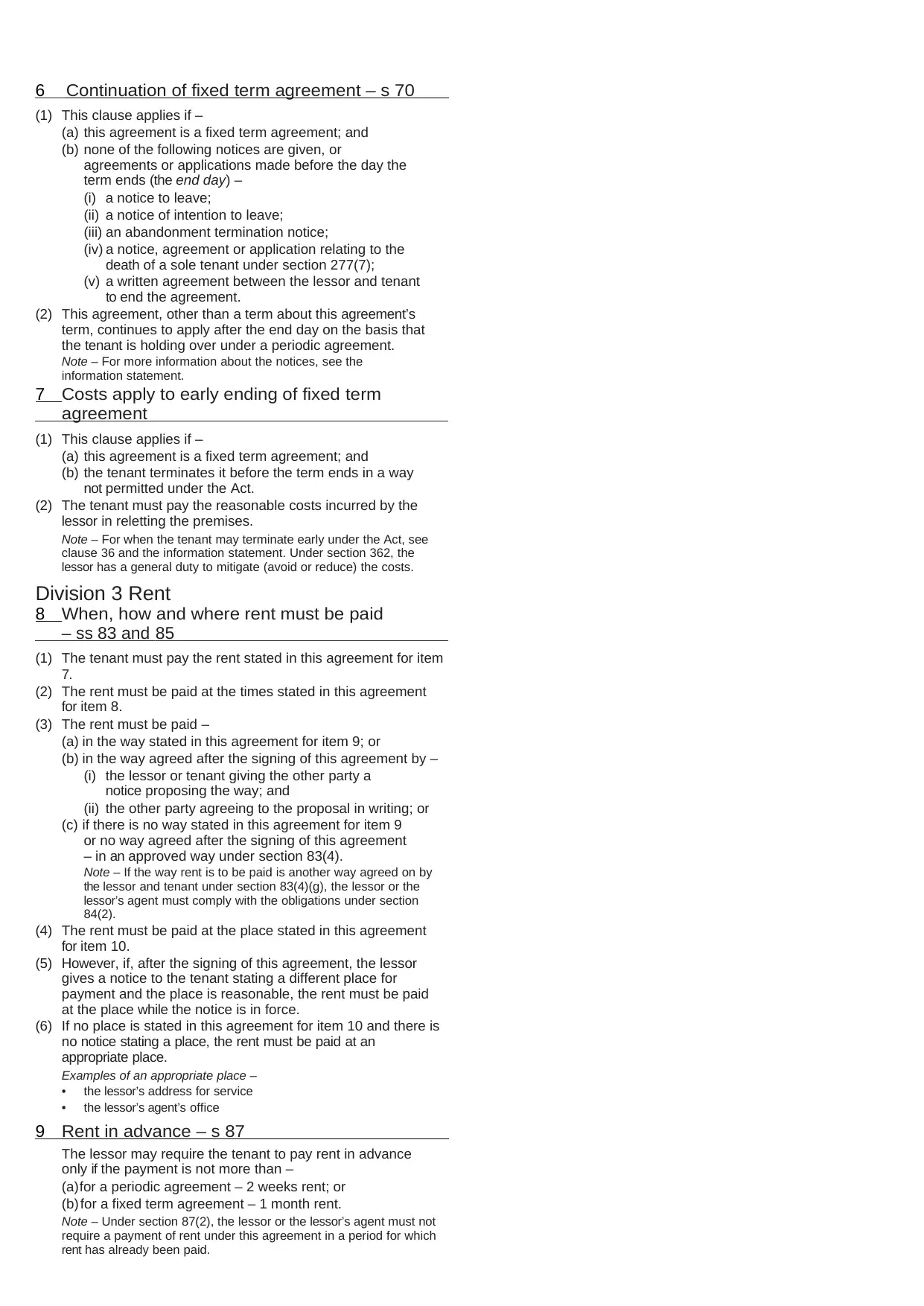
6 Continuation of fixed term agreement – s 70
(1) This clause applies if –
(a) this agreement is a fixed term agreement; and
(b) none of the following notices are given, or
agreements or applications made before the day the
term ends (the end day) –
(i) a notice to leave;
(ii) a notice of intention to leave;
(iii) an abandonment termination notice;
(iv) a notice, agreement or application relating to the
death of a sole tenant under section 277(7);
(v) a written agreement between the lessor and tenant
to end the agreement.
(2) This agreement, other than a term about this agreement’s
term, continues to apply after the end day on the basis that
the tenant is holding over under a periodic agreement.
Note – For more information about the notices, see the
information statement.
7 Costs apply to early ending of fixed term
agreement
(1) This clause applies if –
(a) this agreement is a fixed term agreement; and
(b) the tenant terminates it before the term ends in a way
not permitted under the Act.
(2) The tenant must pay the reasonable costs incurred by the
lessor in reletting the premises.
Note – For when the tenant may terminate early under the Act, see
clause 36 and the information statement. Under section 362, the
lessor has a general duty to mitigate (avoid or reduce) the costs.
Division 3 Rent
8 When, how and where rent must be paid
– ss 83 and 85
(1) The tenant must pay the rent stated in this agreement for item
7.
(2) The rent must be paid at the times stated in this agreement
for item 8.
(3) The rent must be paid –
(a) in the way stated in this agreement for item 9; or
(b) in the way agreed after the signing of this agreement by –
(i) the lessor or tenant giving the other party a
notice proposing the way; and
(ii) the other party agreeing to the proposal in writing; or
(c) if there is no way stated in this agreement for item 9
or no way agreed after the signing of this agreement
– in an approved way under section 83(4).
Note – If the way rent is to be paid is another way agreed on by
the lessor and tenant under section 83(4)(g), the lessor or the
lessor’s agent must comply with the obligations under section
84(2).
(4) The rent must be paid at the place stated in this agreement
for item 10.
(5) However, if, after the signing of this agreement, the lessor
gives a notice to the tenant stating a different place for
payment and the place is reasonable, the rent must be paid
at the place while the notice is in force.
(6) If no place is stated in this agreement for item 10 and there is
no notice stating a place, the rent must be paid at an
appropriate place.
Examples of an appropriate place –
• the lessor’s address for service
• the lessor’s agent’s office
9 Rent in advance – s 87
The lessor may require the tenant to pay rent in advance
only if the payment is not more than –
(a)for a periodic agreement – 2 weeks rent; or
(b) for a fixed term agreement – 1 month rent.
Note – Under section 87(2), the lessor or the lessor’s agent must not
require a payment of rent under this agreement in a period for which
rent has already been paid.
(1) This clause applies if –
(a) this agreement is a fixed term agreement; and
(b) none of the following notices are given, or
agreements or applications made before the day the
term ends (the end day) –
(i) a notice to leave;
(ii) a notice of intention to leave;
(iii) an abandonment termination notice;
(iv) a notice, agreement or application relating to the
death of a sole tenant under section 277(7);
(v) a written agreement between the lessor and tenant
to end the agreement.
(2) This agreement, other than a term about this agreement’s
term, continues to apply after the end day on the basis that
the tenant is holding over under a periodic agreement.
Note – For more information about the notices, see the
information statement.
7 Costs apply to early ending of fixed term
agreement
(1) This clause applies if –
(a) this agreement is a fixed term agreement; and
(b) the tenant terminates it before the term ends in a way
not permitted under the Act.
(2) The tenant must pay the reasonable costs incurred by the
lessor in reletting the premises.
Note – For when the tenant may terminate early under the Act, see
clause 36 and the information statement. Under section 362, the
lessor has a general duty to mitigate (avoid or reduce) the costs.
Division 3 Rent
8 When, how and where rent must be paid
– ss 83 and 85
(1) The tenant must pay the rent stated in this agreement for item
7.
(2) The rent must be paid at the times stated in this agreement
for item 8.
(3) The rent must be paid –
(a) in the way stated in this agreement for item 9; or
(b) in the way agreed after the signing of this agreement by –
(i) the lessor or tenant giving the other party a
notice proposing the way; and
(ii) the other party agreeing to the proposal in writing; or
(c) if there is no way stated in this agreement for item 9
or no way agreed after the signing of this agreement
– in an approved way under section 83(4).
Note – If the way rent is to be paid is another way agreed on by
the lessor and tenant under section 83(4)(g), the lessor or the
lessor’s agent must comply with the obligations under section
84(2).
(4) The rent must be paid at the place stated in this agreement
for item 10.
(5) However, if, after the signing of this agreement, the lessor
gives a notice to the tenant stating a different place for
payment and the place is reasonable, the rent must be paid
at the place while the notice is in force.
(6) If no place is stated in this agreement for item 10 and there is
no notice stating a place, the rent must be paid at an
appropriate place.
Examples of an appropriate place –
• the lessor’s address for service
• the lessor’s agent’s office
9 Rent in advance – s 87
The lessor may require the tenant to pay rent in advance
only if the payment is not more than –
(a)for a periodic agreement – 2 weeks rent; or
(b) for a fixed term agreement – 1 month rent.
Note – Under section 87(2), the lessor or the lessor’s agent must not
require a payment of rent under this agreement in a period for which
rent has already been paid.
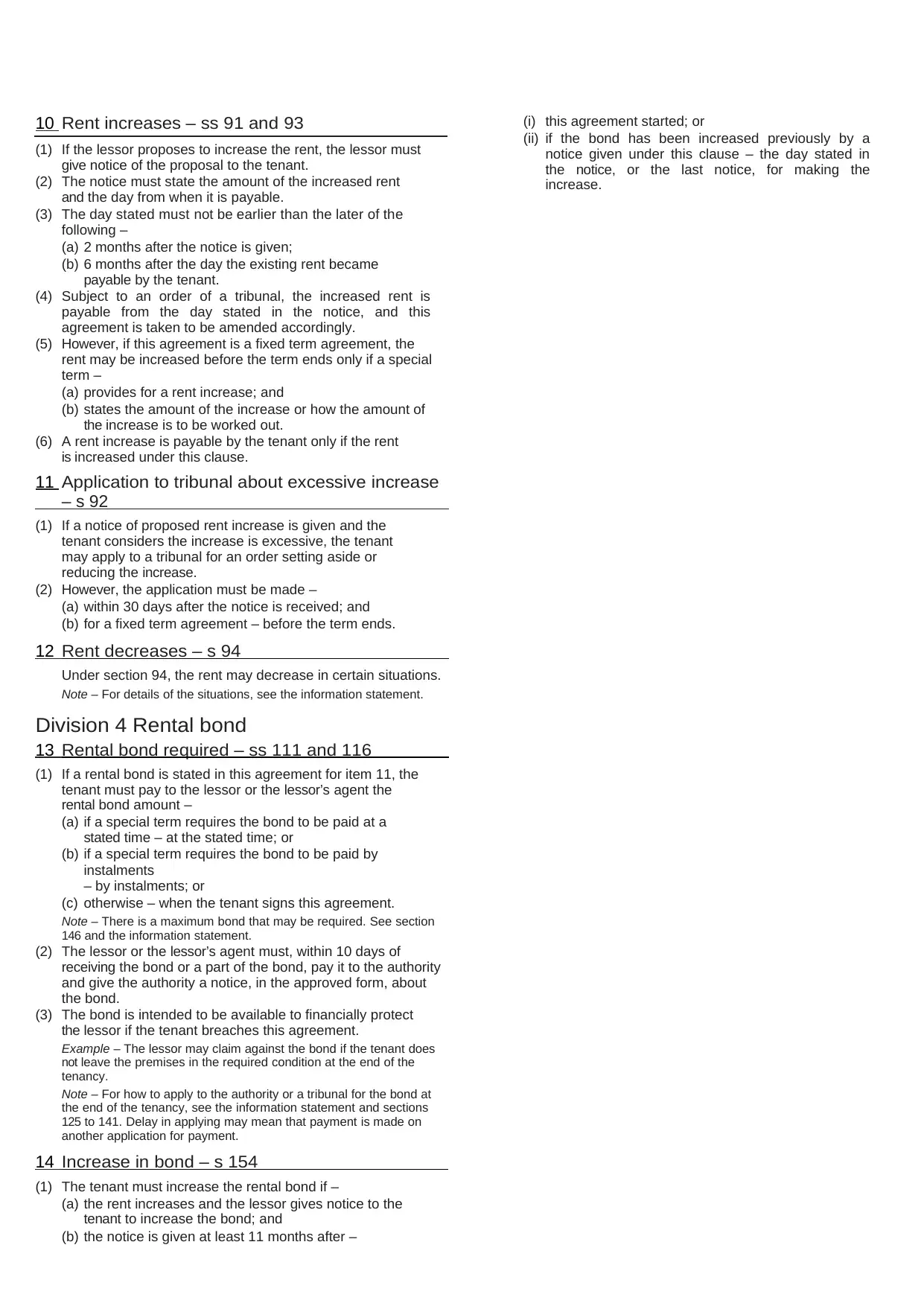
10 Rent increases – ss 91 and 93
(1) If the lessor proposes to increase the rent, the lessor must
give notice of the proposal to the tenant.
(2) The notice must state the amount of the increased rent
and the day from when it is payable.
(3) The day stated must not be earlier than the later of the
following –
(a) 2 months after the notice is given;
(b) 6 months after the day the existing rent became
payable by the tenant.
(4) Subject to an order of a tribunal, the increased rent is
payable from the day stated in the notice, and this
agreement is taken to be amended accordingly.
(5) However, if this agreement is a fixed term agreement, the
rent may be increased before the term ends only if a special
term –
(a) provides for a rent increase; and
(b) states the amount of the increase or how the amount of
the increase is to be worked out.
(6) A rent increase is payable by the tenant only if the rent
is increased under this clause.
11 Application to tribunal about excessive increase
– s 92
(1) If a notice of proposed rent increase is given and the
tenant considers the increase is excessive, the tenant
may apply to a tribunal for an order setting aside or
reducing the increase.
(2) However, the application must be made –
(a) within 30 days after the notice is received; and
(b) for a fixed term agreement – before the term ends.
12 Rent decreases – s 94
Under section 94, the rent may decrease in certain situations.
Note – For details of the situations, see the information statement.
Division 4 Rental bond
13 Rental bond required – ss 111 and 116
(1) If a rental bond is stated in this agreement for item 11, the
tenant must pay to the lessor or the lessor’s agent the
rental bond amount –
(a) if a special term requires the bond to be paid at a
stated time – at the stated time; or
(b) if a special term requires the bond to be paid by
instalments
– by instalments; or
(c) otherwise – when the tenant signs this agreement.
Note – There is a maximum bond that may be required. See section
146 and the information statement.
(2) The lessor or the lessor’s agent must, within 10 days of
receiving the bond or a part of the bond, pay it to the authority
and give the authority a notice, in the approved form, about
the bond.
(3) The bond is intended to be available to financially protect
the lessor if the tenant breaches this agreement.
Example – The lessor may claim against the bond if the tenant does
not leave the premises in the required condition at the end of the
tenancy.
Note – For how to apply to the authority or a tribunal for the bond at
the end of the tenancy, see the information statement and sections
125 to 141. Delay in applying may mean that payment is made on
another application for payment.
14 Increase in bond – s 154
(1) The tenant must increase the rental bond if –
(a) the rent increases and the lessor gives notice to the
tenant to increase the bond; and
(b) the notice is given at least 11 months after –
(i) this agreement started; or
(ii) if the bond has been increased previously by a
notice given under this clause – the day stated in
the notice, or the last notice, for making the
increase.
(1) If the lessor proposes to increase the rent, the lessor must
give notice of the proposal to the tenant.
(2) The notice must state the amount of the increased rent
and the day from when it is payable.
(3) The day stated must not be earlier than the later of the
following –
(a) 2 months after the notice is given;
(b) 6 months after the day the existing rent became
payable by the tenant.
(4) Subject to an order of a tribunal, the increased rent is
payable from the day stated in the notice, and this
agreement is taken to be amended accordingly.
(5) However, if this agreement is a fixed term agreement, the
rent may be increased before the term ends only if a special
term –
(a) provides for a rent increase; and
(b) states the amount of the increase or how the amount of
the increase is to be worked out.
(6) A rent increase is payable by the tenant only if the rent
is increased under this clause.
11 Application to tribunal about excessive increase
– s 92
(1) If a notice of proposed rent increase is given and the
tenant considers the increase is excessive, the tenant
may apply to a tribunal for an order setting aside or
reducing the increase.
(2) However, the application must be made –
(a) within 30 days after the notice is received; and
(b) for a fixed term agreement – before the term ends.
12 Rent decreases – s 94
Under section 94, the rent may decrease in certain situations.
Note – For details of the situations, see the information statement.
Division 4 Rental bond
13 Rental bond required – ss 111 and 116
(1) If a rental bond is stated in this agreement for item 11, the
tenant must pay to the lessor or the lessor’s agent the
rental bond amount –
(a) if a special term requires the bond to be paid at a
stated time – at the stated time; or
(b) if a special term requires the bond to be paid by
instalments
– by instalments; or
(c) otherwise – when the tenant signs this agreement.
Note – There is a maximum bond that may be required. See section
146 and the information statement.
(2) The lessor or the lessor’s agent must, within 10 days of
receiving the bond or a part of the bond, pay it to the authority
and give the authority a notice, in the approved form, about
the bond.
(3) The bond is intended to be available to financially protect
the lessor if the tenant breaches this agreement.
Example – The lessor may claim against the bond if the tenant does
not leave the premises in the required condition at the end of the
tenancy.
Note – For how to apply to the authority or a tribunal for the bond at
the end of the tenancy, see the information statement and sections
125 to 141. Delay in applying may mean that payment is made on
another application for payment.
14 Increase in bond – s 154
(1) The tenant must increase the rental bond if –
(a) the rent increases and the lessor gives notice to the
tenant to increase the bond; and
(b) the notice is given at least 11 months after –
(i) this agreement started; or
(ii) if the bond has been increased previously by a
notice given under this clause – the day stated in
the notice, or the last notice, for making the
increase.
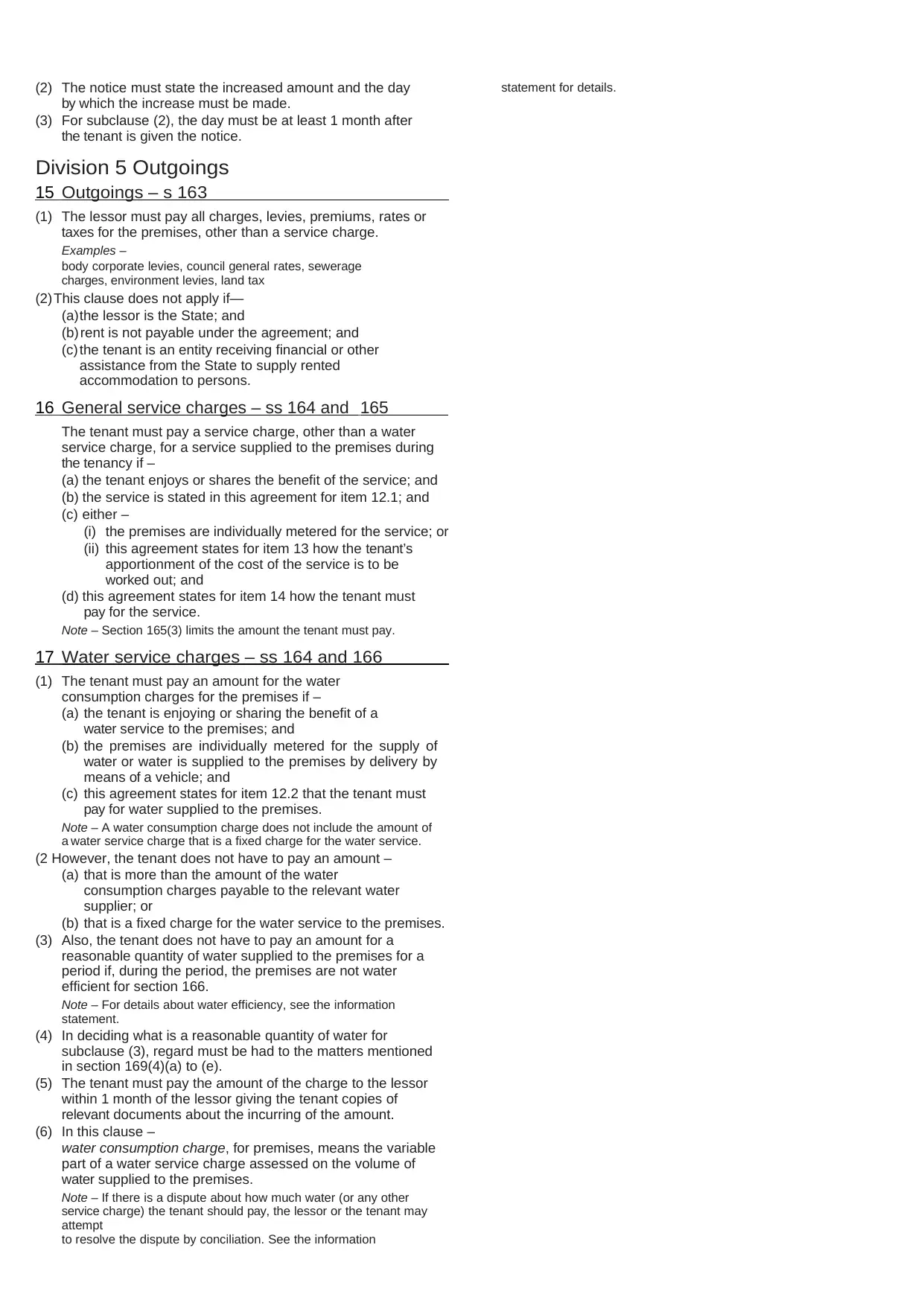
(2) The notice must state the increased amount and the day
by which the increase must be made.
(3) For subclause (2), the day must be at least 1 month after
the tenant is given the notice.
Division 5 Outgoings
15 Outgoings – s 163
(1) The lessor must pay all charges, levies, premiums, rates or
taxes for the premises, other than a service charge.
Examples –
body corporate levies, council general rates, sewerage
charges, environment levies, land tax
(2)This clause does not apply if—
(a)the lessor is the State; and
(b) rent is not payable under the agreement; and
(c) the tenant is an entity receiving financial or other
assistance from the State to supply rented
accommodation to persons.
16 General service charges – ss 164 and 165
The tenant must pay a service charge, other than a water
service charge, for a service supplied to the premises during
the tenancy if –
(a) the tenant enjoys or shares the benefit of the service; and
(b) the service is stated in this agreement for item 12.1; and
(c) either –
(i) the premises are individually metered for the service; or
(ii) this agreement states for item 13 how the tenant’s
apportionment of the cost of the service is to be
worked out; and
(d) this agreement states for item 14 how the tenant must
pay for the service.
Note – Section 165(3) limits the amount the tenant must pay.
17 Water service charges – ss 164 and 166
(1) The tenant must pay an amount for the water
consumption charges for the premises if –
(a) the tenant is enjoying or sharing the benefit of a
water service to the premises; and
(b) the premises are individually metered for the supply of
water or water is supplied to the premises by delivery by
means of a vehicle; and
(c) this agreement states for item 12.2 that the tenant must
pay for water supplied to the premises.
Note – A water consumption charge does not include the amount of
a water service charge that is a fixed charge for the water service.
(2 However, the tenant does not have to pay an amount –
(a) that is more than the amount of the water
consumption charges payable to the relevant water
supplier; or
(b) that is a fixed charge for the water service to the premises.
(3) Also, the tenant does not have to pay an amount for a
reasonable quantity of water supplied to the premises for a
period if, during the period, the premises are not water
efficient for section 166.
Note – For details about water efficiency, see the information
statement.
(4) In deciding what is a reasonable quantity of water for
subclause (3), regard must be had to the matters mentioned
in section 169(4)(a) to (e).
(5) The tenant must pay the amount of the charge to the lessor
within 1 month of the lessor giving the tenant copies of
relevant documents about the incurring of the amount.
(6) In this clause –
water consumption charge, for premises, means the variable
part of a water service charge assessed on the volume of
water supplied to the premises.
Note – If there is a dispute about how much water (or any other
service charge) the tenant should pay, the lessor or the tenant may
attempt
to resolve the dispute by conciliation. See the information
statement for details.
by which the increase must be made.
(3) For subclause (2), the day must be at least 1 month after
the tenant is given the notice.
Division 5 Outgoings
15 Outgoings – s 163
(1) The lessor must pay all charges, levies, premiums, rates or
taxes for the premises, other than a service charge.
Examples –
body corporate levies, council general rates, sewerage
charges, environment levies, land tax
(2)This clause does not apply if—
(a)the lessor is the State; and
(b) rent is not payable under the agreement; and
(c) the tenant is an entity receiving financial or other
assistance from the State to supply rented
accommodation to persons.
16 General service charges – ss 164 and 165
The tenant must pay a service charge, other than a water
service charge, for a service supplied to the premises during
the tenancy if –
(a) the tenant enjoys or shares the benefit of the service; and
(b) the service is stated in this agreement for item 12.1; and
(c) either –
(i) the premises are individually metered for the service; or
(ii) this agreement states for item 13 how the tenant’s
apportionment of the cost of the service is to be
worked out; and
(d) this agreement states for item 14 how the tenant must
pay for the service.
Note – Section 165(3) limits the amount the tenant must pay.
17 Water service charges – ss 164 and 166
(1) The tenant must pay an amount for the water
consumption charges for the premises if –
(a) the tenant is enjoying or sharing the benefit of a
water service to the premises; and
(b) the premises are individually metered for the supply of
water or water is supplied to the premises by delivery by
means of a vehicle; and
(c) this agreement states for item 12.2 that the tenant must
pay for water supplied to the premises.
Note – A water consumption charge does not include the amount of
a water service charge that is a fixed charge for the water service.
(2 However, the tenant does not have to pay an amount –
(a) that is more than the amount of the water
consumption charges payable to the relevant water
supplier; or
(b) that is a fixed charge for the water service to the premises.
(3) Also, the tenant does not have to pay an amount for a
reasonable quantity of water supplied to the premises for a
period if, during the period, the premises are not water
efficient for section 166.
Note – For details about water efficiency, see the information
statement.
(4) In deciding what is a reasonable quantity of water for
subclause (3), regard must be had to the matters mentioned
in section 169(4)(a) to (e).
(5) The tenant must pay the amount of the charge to the lessor
within 1 month of the lessor giving the tenant copies of
relevant documents about the incurring of the amount.
(6) In this clause –
water consumption charge, for premises, means the variable
part of a water service charge assessed on the volume of
water supplied to the premises.
Note – If there is a dispute about how much water (or any other
service charge) the tenant should pay, the lessor or the tenant may
attempt
to resolve the dispute by conciliation. See the information
statement for details.
Paraphrase This Document
Need a fresh take? Get an instant paraphrase of this document with our AI Paraphraser
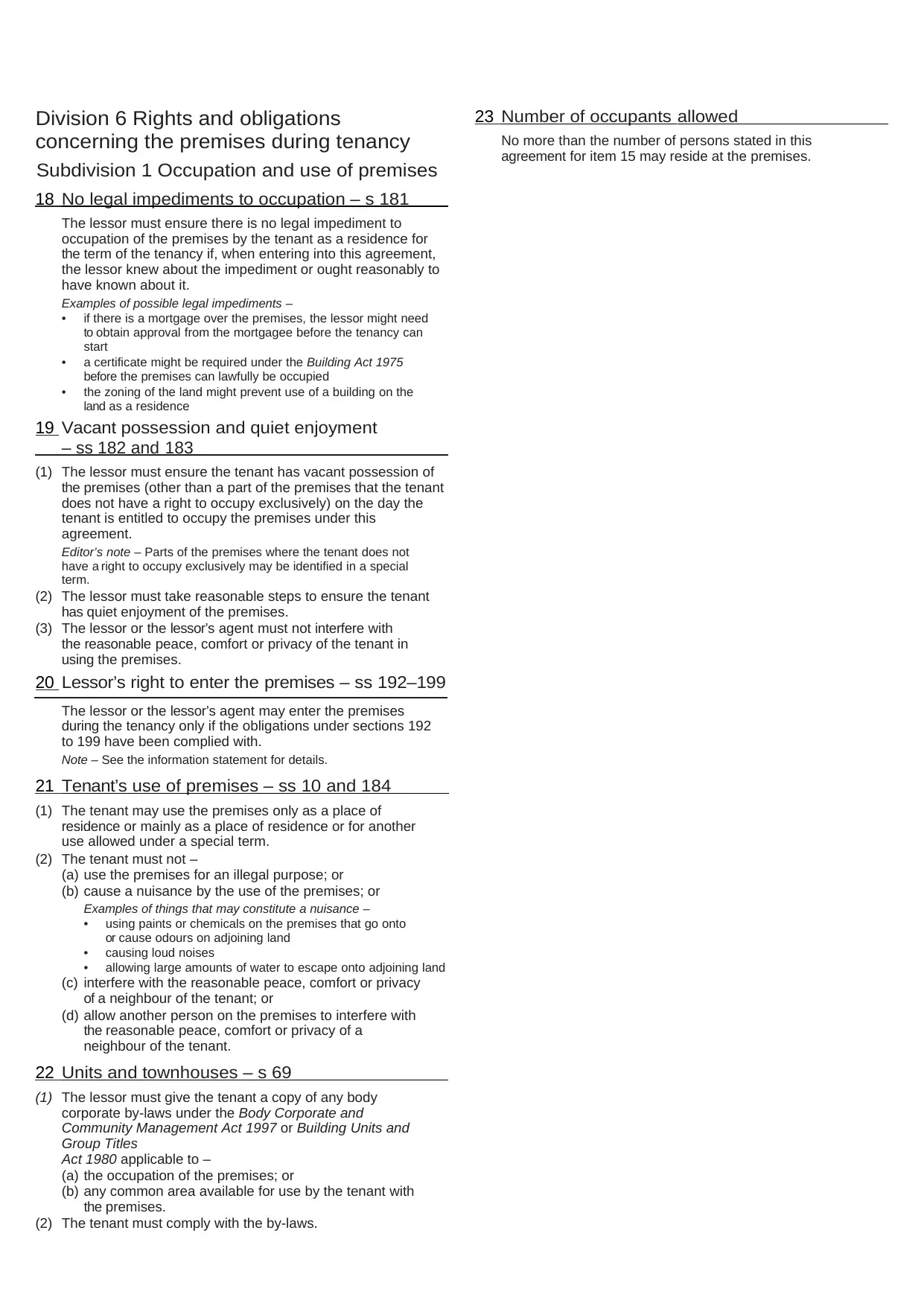
Division 6 Rights and obligations
concerning the premises during tenancy
Subdivision 1 Occupation and use of premises
18 No legal impediments to occupation – s 181
The lessor must ensure there is no legal impediment to
occupation of the premises by the tenant as a residence for
the term of the tenancy if, when entering into this agreement,
the lessor knew about the impediment or ought reasonably to
have known about it.
Examples of possible legal impediments –
• if there is a mortgage over the premises, the lessor might need
to obtain approval from the mortgagee before the tenancy can
start
• a certificate might be required under the Building Act 1975
before the premises can lawfully be occupied
• the zoning of the land might prevent use of a building on the
land as a residence
19 Vacant possession and quiet enjoyment
– ss 182 and 183
(1) The lessor must ensure the tenant has vacant possession of
the premises (other than a part of the premises that the tenant
does not have a right to occupy exclusively) on the day the
tenant is entitled to occupy the premises under this
agreement.
Editor’s note – Parts of the premises where the tenant does not
have a right to occupy exclusively may be identified in a special
term.
(2) The lessor must take reasonable steps to ensure the tenant
has quiet enjoyment of the premises.
(3) The lessor or the lessor’s agent must not interfere with
the reasonable peace, comfort or privacy of the tenant in
using the premises.
20 Lessor’s right to enter the premises – ss 192–199
The lessor or the lessor’s agent may enter the premises
during the tenancy only if the obligations under sections 192
to 199 have been complied with.
Note – See the information statement for details.
21 Tenant’s use of premises – ss 10 and 184
(1) The tenant may use the premises only as a place of
residence or mainly as a place of residence or for another
use allowed under a special term.
(2) The tenant must not –
(a) use the premises for an illegal purpose; or
(b) cause a nuisance by the use of the premises; or
Examples of things that may constitute a nuisance –
• using paints or chemicals on the premises that go onto
or cause odours on adjoining land
• causing loud noises
• allowing large amounts of water to escape onto adjoining land
(c) interfere with the reasonable peace, comfort or privacy
of a neighbour of the tenant; or
(d) allow another person on the premises to interfere with
the reasonable peace, comfort or privacy of a
neighbour of the tenant.
22 Units and townhouses – s 69
(1) The lessor must give the tenant a copy of any body
corporate by-laws under the Body Corporate and
Community Management Act 1997 or Building Units and
Group Titles
Act 1980 applicable to –
(a) the occupation of the premises; or
(b) any common area available for use by the tenant with
the premises.
(2) The tenant must comply with the by-laws.
23 Number of occupants allowed
No more than the number of persons stated in this
agreement for item 15 may reside at the premises.
concerning the premises during tenancy
Subdivision 1 Occupation and use of premises
18 No legal impediments to occupation – s 181
The lessor must ensure there is no legal impediment to
occupation of the premises by the tenant as a residence for
the term of the tenancy if, when entering into this agreement,
the lessor knew about the impediment or ought reasonably to
have known about it.
Examples of possible legal impediments –
• if there is a mortgage over the premises, the lessor might need
to obtain approval from the mortgagee before the tenancy can
start
• a certificate might be required under the Building Act 1975
before the premises can lawfully be occupied
• the zoning of the land might prevent use of a building on the
land as a residence
19 Vacant possession and quiet enjoyment
– ss 182 and 183
(1) The lessor must ensure the tenant has vacant possession of
the premises (other than a part of the premises that the tenant
does not have a right to occupy exclusively) on the day the
tenant is entitled to occupy the premises under this
agreement.
Editor’s note – Parts of the premises where the tenant does not
have a right to occupy exclusively may be identified in a special
term.
(2) The lessor must take reasonable steps to ensure the tenant
has quiet enjoyment of the premises.
(3) The lessor or the lessor’s agent must not interfere with
the reasonable peace, comfort or privacy of the tenant in
using the premises.
20 Lessor’s right to enter the premises – ss 192–199
The lessor or the lessor’s agent may enter the premises
during the tenancy only if the obligations under sections 192
to 199 have been complied with.
Note – See the information statement for details.
21 Tenant’s use of premises – ss 10 and 184
(1) The tenant may use the premises only as a place of
residence or mainly as a place of residence or for another
use allowed under a special term.
(2) The tenant must not –
(a) use the premises for an illegal purpose; or
(b) cause a nuisance by the use of the premises; or
Examples of things that may constitute a nuisance –
• using paints or chemicals on the premises that go onto
or cause odours on adjoining land
• causing loud noises
• allowing large amounts of water to escape onto adjoining land
(c) interfere with the reasonable peace, comfort or privacy
of a neighbour of the tenant; or
(d) allow another person on the premises to interfere with
the reasonable peace, comfort or privacy of a
neighbour of the tenant.
22 Units and townhouses – s 69
(1) The lessor must give the tenant a copy of any body
corporate by-laws under the Body Corporate and
Community Management Act 1997 or Building Units and
Group Titles
Act 1980 applicable to –
(a) the occupation of the premises; or
(b) any common area available for use by the tenant with
the premises.
(2) The tenant must comply with the by-laws.
23 Number of occupants allowed
No more than the number of persons stated in this
agreement for item 15 may reside at the premises.
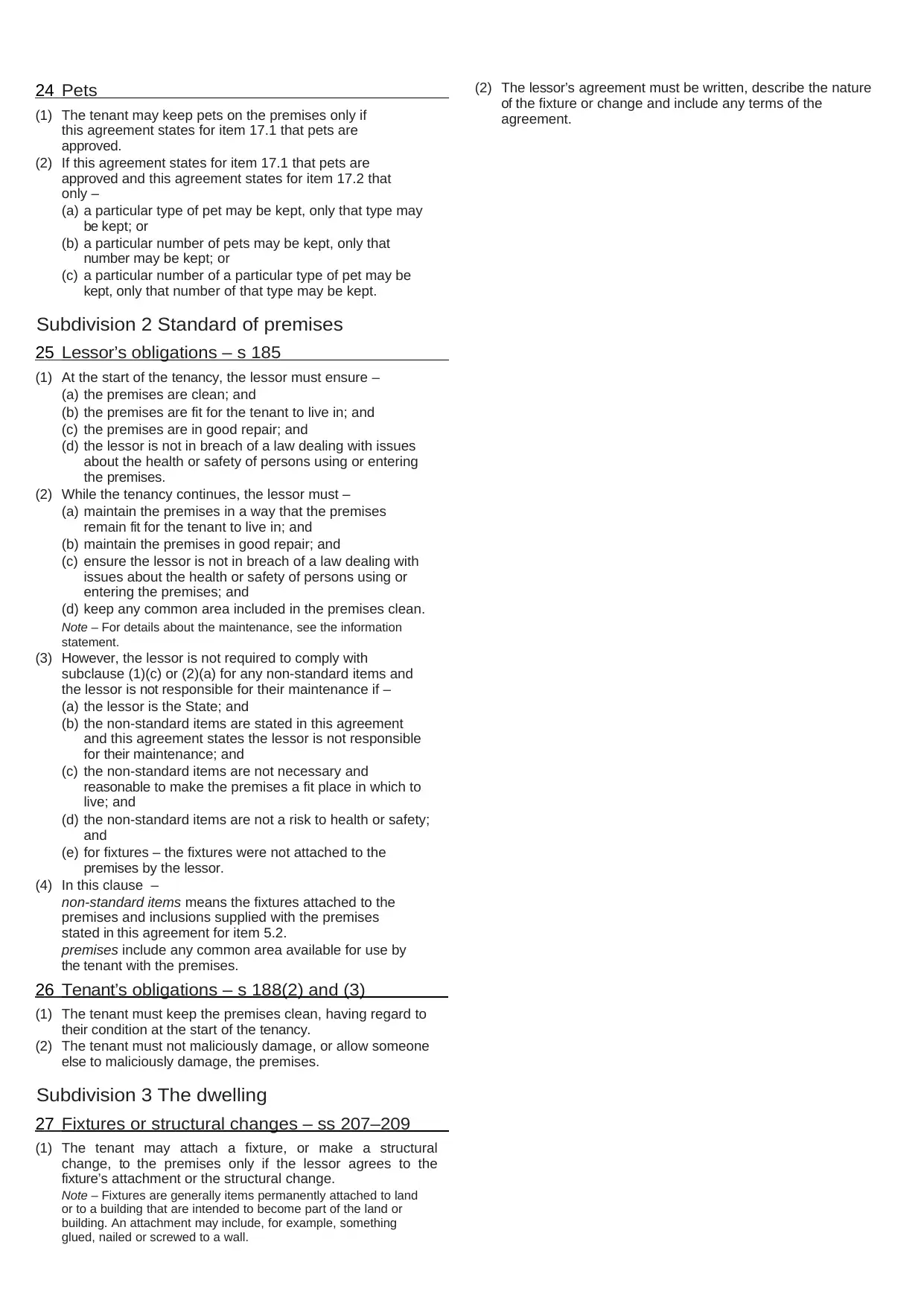
24 Pets
(1) The tenant may keep pets on the premises only if
this agreement states for item 17.1 that pets are
approved.
(2) If this agreement states for item 17.1 that pets are
approved and this agreement states for item 17.2 that
only –
(a) a particular type of pet may be kept, only that type may
be kept; or
(b) a particular number of pets may be kept, only that
number may be kept; or
(c) a particular number of a particular type of pet may be
kept, only that number of that type may be kept.
Subdivision 2 Standard of premises
25 Lessor’s obligations – s 185
(1) At the start of the tenancy, the lessor must ensure –
(a) the premises are clean; and
(b) the premises are fit for the tenant to live in; and
(c) the premises are in good repair; and
(d) the lessor is not in breach of a law dealing with issues
about the health or safety of persons using or entering
the premises.
(2) While the tenancy continues, the lessor must –
(a) maintain the premises in a way that the premises
remain fit for the tenant to live in; and
(b) maintain the premises in good repair; and
(c) ensure the lessor is not in breach of a law dealing with
issues about the health or safety of persons using or
entering the premises; and
(d) keep any common area included in the premises clean.
Note – For details about the maintenance, see the information
statement.
(3) However, the lessor is not required to comply with
subclause (1)(c) or (2)(a) for any non-standard items and
the lessor is not responsible for their maintenance if –
(a) the lessor is the State; and
(b) the non-standard items are stated in this agreement
and this agreement states the lessor is not responsible
for their maintenance; and
(c) the non-standard items are not necessary and
reasonable to make the premises a fit place in which to
live; and
(d) the non-standard items are not a risk to health or safety;
and
(e) for fixtures – the fixtures were not attached to the
premises by the lessor.
(4) In this clause –
non-standard items means the fixtures attached to the
premises and inclusions supplied with the premises
stated in this agreement for item 5.2.
premises include any common area available for use by
the tenant with the premises.
26 Tenant’s obligations – s 188(2) and (3)
(1) The tenant must keep the premises clean, having regard to
their condition at the start of the tenancy.
(2) The tenant must not maliciously damage, or allow someone
else to maliciously damage, the premises.
Subdivision 3 The dwelling
27 Fixtures or structural changes – ss 207–209
(1) The tenant may attach a fixture, or make a structural
change, to the premises only if the lessor agrees to the
fixture’s attachment or the structural change.
Note – Fixtures are generally items permanently attached to land
or to a building that are intended to become part of the land or
building. An attachment may include, for example, something
glued, nailed or screwed to a wall.
(2) The lessor’s agreement must be written, describe the nature
of the fixture or change and include any terms of the
agreement.
(1) The tenant may keep pets on the premises only if
this agreement states for item 17.1 that pets are
approved.
(2) If this agreement states for item 17.1 that pets are
approved and this agreement states for item 17.2 that
only –
(a) a particular type of pet may be kept, only that type may
be kept; or
(b) a particular number of pets may be kept, only that
number may be kept; or
(c) a particular number of a particular type of pet may be
kept, only that number of that type may be kept.
Subdivision 2 Standard of premises
25 Lessor’s obligations – s 185
(1) At the start of the tenancy, the lessor must ensure –
(a) the premises are clean; and
(b) the premises are fit for the tenant to live in; and
(c) the premises are in good repair; and
(d) the lessor is not in breach of a law dealing with issues
about the health or safety of persons using or entering
the premises.
(2) While the tenancy continues, the lessor must –
(a) maintain the premises in a way that the premises
remain fit for the tenant to live in; and
(b) maintain the premises in good repair; and
(c) ensure the lessor is not in breach of a law dealing with
issues about the health or safety of persons using or
entering the premises; and
(d) keep any common area included in the premises clean.
Note – For details about the maintenance, see the information
statement.
(3) However, the lessor is not required to comply with
subclause (1)(c) or (2)(a) for any non-standard items and
the lessor is not responsible for their maintenance if –
(a) the lessor is the State; and
(b) the non-standard items are stated in this agreement
and this agreement states the lessor is not responsible
for their maintenance; and
(c) the non-standard items are not necessary and
reasonable to make the premises a fit place in which to
live; and
(d) the non-standard items are not a risk to health or safety;
and
(e) for fixtures – the fixtures were not attached to the
premises by the lessor.
(4) In this clause –
non-standard items means the fixtures attached to the
premises and inclusions supplied with the premises
stated in this agreement for item 5.2.
premises include any common area available for use by
the tenant with the premises.
26 Tenant’s obligations – s 188(2) and (3)
(1) The tenant must keep the premises clean, having regard to
their condition at the start of the tenancy.
(2) The tenant must not maliciously damage, or allow someone
else to maliciously damage, the premises.
Subdivision 3 The dwelling
27 Fixtures or structural changes – ss 207–209
(1) The tenant may attach a fixture, or make a structural
change, to the premises only if the lessor agrees to the
fixture’s attachment or the structural change.
Note – Fixtures are generally items permanently attached to land
or to a building that are intended to become part of the land or
building. An attachment may include, for example, something
glued, nailed or screwed to a wall.
(2) The lessor’s agreement must be written, describe the nature
of the fixture or change and include any terms of the
agreement.
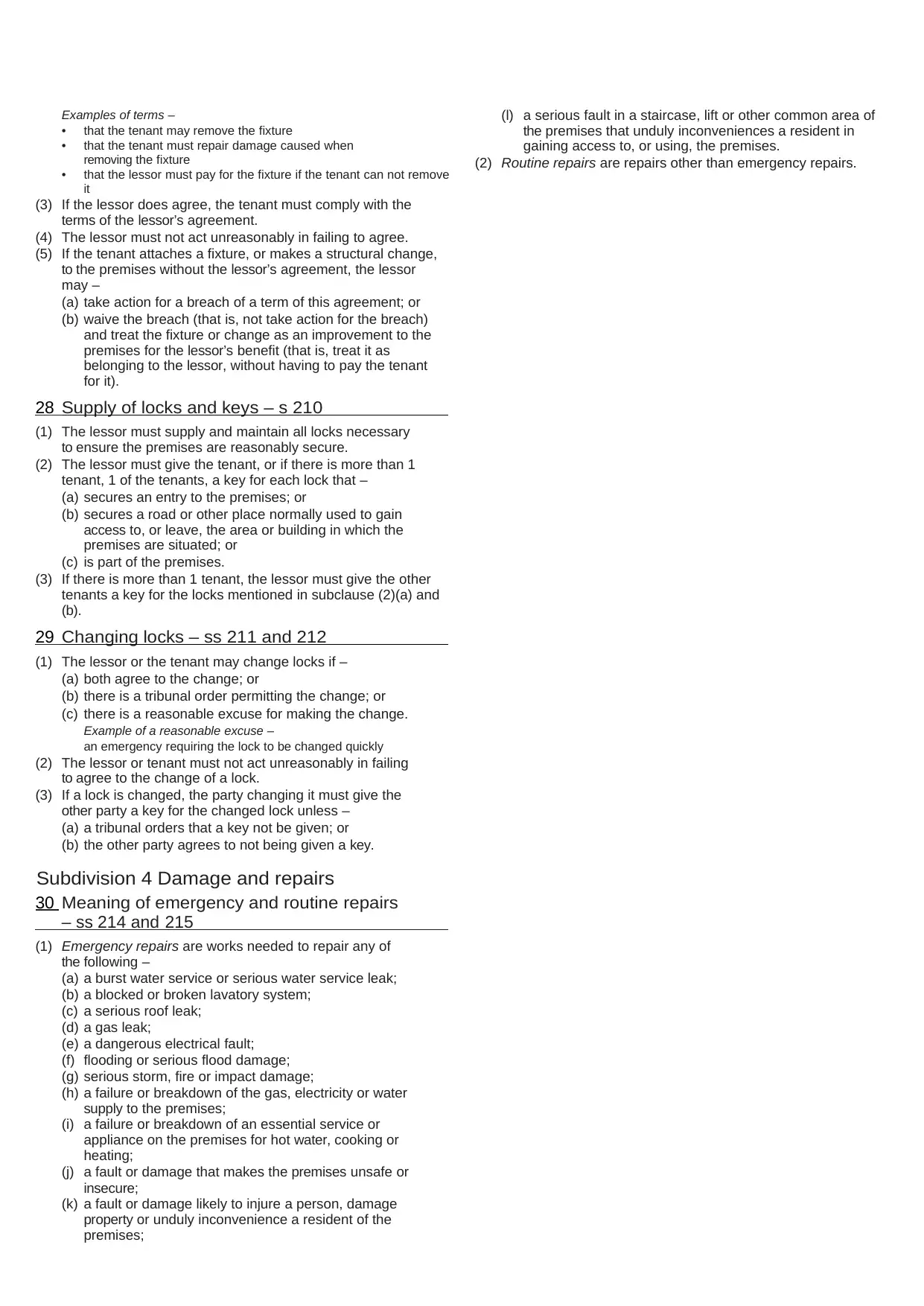
Examples of terms –
• that the tenant may remove the fixture
• that the tenant must repair damage caused when
removing the fixture
• that the lessor must pay for the fixture if the tenant can not remove
it
(3) If the lessor does agree, the tenant must comply with the
terms of the lessor’s agreement.
(4) The lessor must not act unreasonably in failing to agree.
(5) If the tenant attaches a fixture, or makes a structural change,
to the premises without the lessor’s agreement, the lessor
may –
(a) take action for a breach of a term of this agreement; or
(b) waive the breach (that is, not take action for the breach)
and treat the fixture or change as an improvement to the
premises for the lessor’s benefit (that is, treat it as
belonging to the lessor, without having to pay the tenant
for it).
28 Supply of locks and keys – s 210
(1) The lessor must supply and maintain all locks necessary
to ensure the premises are reasonably secure.
(2) The lessor must give the tenant, or if there is more than 1
tenant, 1 of the tenants, a key for each lock that –
(a) secures an entry to the premises; or
(b) secures a road or other place normally used to gain
access to, or leave, the area or building in which the
premises are situated; or
(c) is part of the premises.
(3) If there is more than 1 tenant, the lessor must give the other
tenants a key for the locks mentioned in subclause (2)(a) and
(b).
29 Changing locks – ss 211 and 212
(1) The lessor or the tenant may change locks if –
(a) both agree to the change; or
(b) there is a tribunal order permitting the change; or
(c) there is a reasonable excuse for making the change.
Example of a reasonable excuse –
an emergency requiring the lock to be changed quickly
(2) The lessor or tenant must not act unreasonably in failing
to agree to the change of a lock.
(3) If a lock is changed, the party changing it must give the
other party a key for the changed lock unless –
(a) a tribunal orders that a key not be given; or
(b) the other party agrees to not being given a key.
Subdivision 4 Damage and repairs
30 Meaning of emergency and routine repairs
– ss 214 and 215
(1) Emergency repairs are works needed to repair any of
the following –
(a) a burst water service or serious water service leak;
(b) a blocked or broken lavatory system;
(c) a serious roof leak;
(d) a gas leak;
(e) a dangerous electrical fault;
(f) flooding or serious flood damage;
(g) serious storm, fire or impact damage;
(h) a failure or breakdown of the gas, electricity or water
supply to the premises;
(i) a failure or breakdown of an essential service or
appliance on the premises for hot water, cooking or
heating;
(j) a fault or damage that makes the premises unsafe or
insecure;
(k) a fault or damage likely to injure a person, damage
property or unduly inconvenience a resident of the
premises;
(l) a serious fault in a staircase, lift or other common area of
the premises that unduly inconveniences a resident in
gaining access to, or using, the premises.
(2) Routine repairs are repairs other than emergency repairs.
• that the tenant may remove the fixture
• that the tenant must repair damage caused when
removing the fixture
• that the lessor must pay for the fixture if the tenant can not remove
it
(3) If the lessor does agree, the tenant must comply with the
terms of the lessor’s agreement.
(4) The lessor must not act unreasonably in failing to agree.
(5) If the tenant attaches a fixture, or makes a structural change,
to the premises without the lessor’s agreement, the lessor
may –
(a) take action for a breach of a term of this agreement; or
(b) waive the breach (that is, not take action for the breach)
and treat the fixture or change as an improvement to the
premises for the lessor’s benefit (that is, treat it as
belonging to the lessor, without having to pay the tenant
for it).
28 Supply of locks and keys – s 210
(1) The lessor must supply and maintain all locks necessary
to ensure the premises are reasonably secure.
(2) The lessor must give the tenant, or if there is more than 1
tenant, 1 of the tenants, a key for each lock that –
(a) secures an entry to the premises; or
(b) secures a road or other place normally used to gain
access to, or leave, the area or building in which the
premises are situated; or
(c) is part of the premises.
(3) If there is more than 1 tenant, the lessor must give the other
tenants a key for the locks mentioned in subclause (2)(a) and
(b).
29 Changing locks – ss 211 and 212
(1) The lessor or the tenant may change locks if –
(a) both agree to the change; or
(b) there is a tribunal order permitting the change; or
(c) there is a reasonable excuse for making the change.
Example of a reasonable excuse –
an emergency requiring the lock to be changed quickly
(2) The lessor or tenant must not act unreasonably in failing
to agree to the change of a lock.
(3) If a lock is changed, the party changing it must give the
other party a key for the changed lock unless –
(a) a tribunal orders that a key not be given; or
(b) the other party agrees to not being given a key.
Subdivision 4 Damage and repairs
30 Meaning of emergency and routine repairs
– ss 214 and 215
(1) Emergency repairs are works needed to repair any of
the following –
(a) a burst water service or serious water service leak;
(b) a blocked or broken lavatory system;
(c) a serious roof leak;
(d) a gas leak;
(e) a dangerous electrical fault;
(f) flooding or serious flood damage;
(g) serious storm, fire or impact damage;
(h) a failure or breakdown of the gas, electricity or water
supply to the premises;
(i) a failure or breakdown of an essential service or
appliance on the premises for hot water, cooking or
heating;
(j) a fault or damage that makes the premises unsafe or
insecure;
(k) a fault or damage likely to injure a person, damage
property or unduly inconvenience a resident of the
premises;
(l) a serious fault in a staircase, lift or other common area of
the premises that unduly inconveniences a resident in
gaining access to, or using, the premises.
(2) Routine repairs are repairs other than emergency repairs.
Secure Best Marks with AI Grader
Need help grading? Try our AI Grader for instant feedback on your assignments.
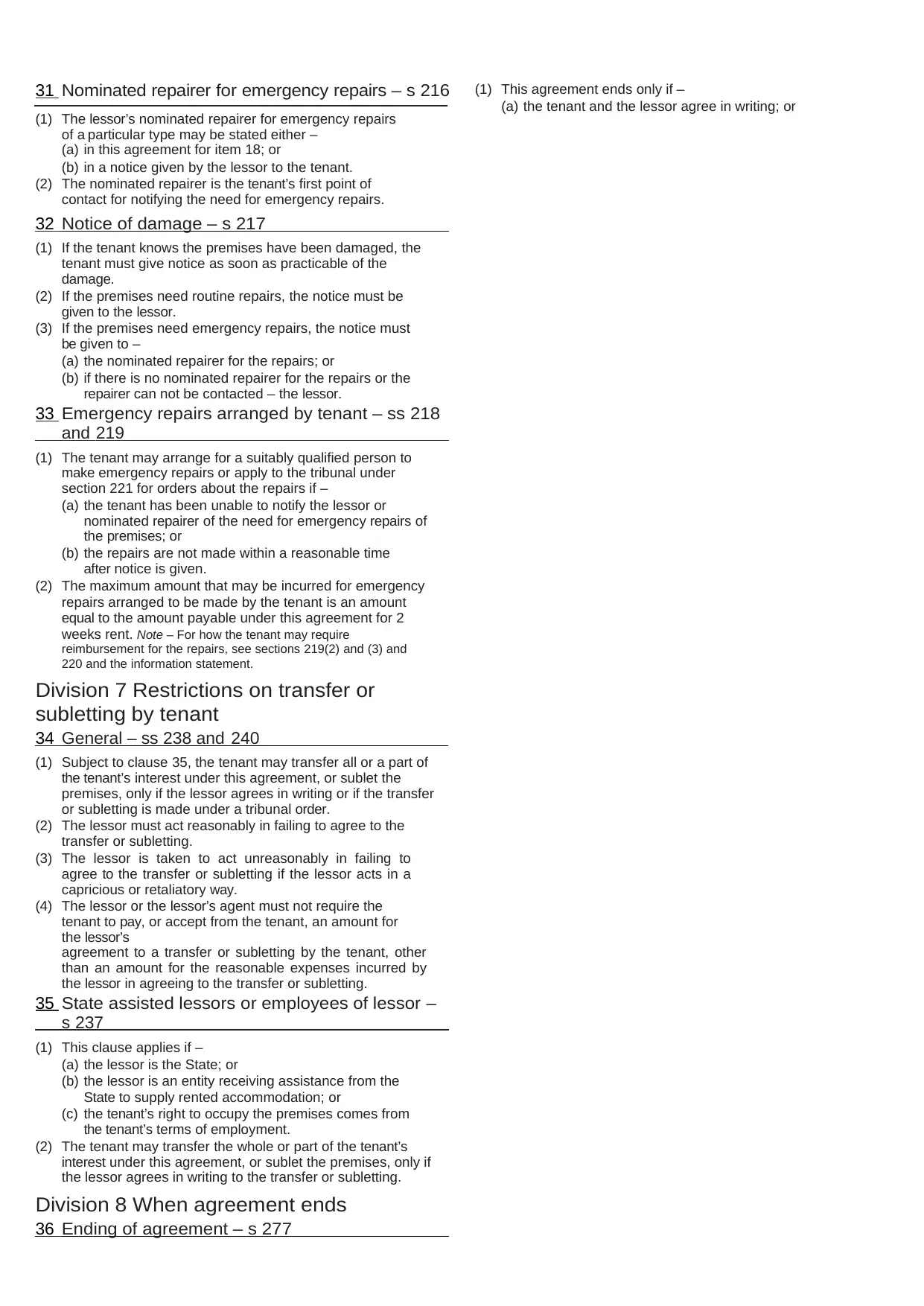
31 Nominated repairer for emergency repairs – s 216
(1) The lessor’s nominated repairer for emergency repairs
of a particular type may be stated either –
(a) in this agreement for item 18; or
(b) in a notice given by the lessor to the tenant.
(2) The nominated repairer is the tenant’s first point of
contact for notifying the need for emergency repairs.
32 Notice of damage – s 217
(1) If the tenant knows the premises have been damaged, the
tenant must give notice as soon as practicable of the
damage.
(2) If the premises need routine repairs, the notice must be
given to the lessor.
(3) If the premises need emergency repairs, the notice must
be given to –
(a) the nominated repairer for the repairs; or
(b) if there is no nominated repairer for the repairs or the
repairer can not be contacted – the lessor.
33 Emergency repairs arranged by tenant – ss 218
and 219
(1) The tenant may arrange for a suitably qualified person to
make emergency repairs or apply to the tribunal under
section 221 for orders about the repairs if –
(a) the tenant has been unable to notify the lessor or
nominated repairer of the need for emergency repairs of
the premises; or
(b) the repairs are not made within a reasonable time
after notice is given.
(2) The maximum amount that may be incurred for emergency
repairs arranged to be made by the tenant is an amount
equal to the amount payable under this agreement for 2
weeks rent. Note – For how the tenant may require
reimbursement for the repairs, see sections 219(2) and (3) and
220 and the information statement.
Division 7 Restrictions on transfer or
subletting by tenant
34 General – ss 238 and 240
(1) Subject to clause 35, the tenant may transfer all or a part of
the tenant’s interest under this agreement, or sublet the
premises, only if the lessor agrees in writing or if the transfer
or subletting is made under a tribunal order.
(2) The lessor must act reasonably in failing to agree to the
transfer or subletting.
(3) The lessor is taken to act unreasonably in failing to
agree to the transfer or subletting if the lessor acts in a
capricious or retaliatory way.
(4) The lessor or the lessor’s agent must not require the
tenant to pay, or accept from the tenant, an amount for
the lessor’s
agreement to a transfer or subletting by the tenant, other
than an amount for the reasonable expenses incurred by
the lessor in agreeing to the transfer or subletting.
35 State assisted lessors or employees of lessor –
s 237
(1) This clause applies if –
(a) the lessor is the State; or
(b) the lessor is an entity receiving assistance from the
State to supply rented accommodation; or
(c) the tenant’s right to occupy the premises comes from
the tenant’s terms of employment.
(2) The tenant may transfer the whole or part of the tenant’s
interest under this agreement, or sublet the premises, only if
the lessor agrees in writing to the transfer or subletting.
Division 8 When agreement ends
36 Ending of agreement – s 277
(1) This agreement ends only if –
(a) the tenant and the lessor agree in writing; or
(1) The lessor’s nominated repairer for emergency repairs
of a particular type may be stated either –
(a) in this agreement for item 18; or
(b) in a notice given by the lessor to the tenant.
(2) The nominated repairer is the tenant’s first point of
contact for notifying the need for emergency repairs.
32 Notice of damage – s 217
(1) If the tenant knows the premises have been damaged, the
tenant must give notice as soon as practicable of the
damage.
(2) If the premises need routine repairs, the notice must be
given to the lessor.
(3) If the premises need emergency repairs, the notice must
be given to –
(a) the nominated repairer for the repairs; or
(b) if there is no nominated repairer for the repairs or the
repairer can not be contacted – the lessor.
33 Emergency repairs arranged by tenant – ss 218
and 219
(1) The tenant may arrange for a suitably qualified person to
make emergency repairs or apply to the tribunal under
section 221 for orders about the repairs if –
(a) the tenant has been unable to notify the lessor or
nominated repairer of the need for emergency repairs of
the premises; or
(b) the repairs are not made within a reasonable time
after notice is given.
(2) The maximum amount that may be incurred for emergency
repairs arranged to be made by the tenant is an amount
equal to the amount payable under this agreement for 2
weeks rent. Note – For how the tenant may require
reimbursement for the repairs, see sections 219(2) and (3) and
220 and the information statement.
Division 7 Restrictions on transfer or
subletting by tenant
34 General – ss 238 and 240
(1) Subject to clause 35, the tenant may transfer all or a part of
the tenant’s interest under this agreement, or sublet the
premises, only if the lessor agrees in writing or if the transfer
or subletting is made under a tribunal order.
(2) The lessor must act reasonably in failing to agree to the
transfer or subletting.
(3) The lessor is taken to act unreasonably in failing to
agree to the transfer or subletting if the lessor acts in a
capricious or retaliatory way.
(4) The lessor or the lessor’s agent must not require the
tenant to pay, or accept from the tenant, an amount for
the lessor’s
agreement to a transfer or subletting by the tenant, other
than an amount for the reasonable expenses incurred by
the lessor in agreeing to the transfer or subletting.
35 State assisted lessors or employees of lessor –
s 237
(1) This clause applies if –
(a) the lessor is the State; or
(b) the lessor is an entity receiving assistance from the
State to supply rented accommodation; or
(c) the tenant’s right to occupy the premises comes from
the tenant’s terms of employment.
(2) The tenant may transfer the whole or part of the tenant’s
interest under this agreement, or sublet the premises, only if
the lessor agrees in writing to the transfer or subletting.
Division 8 When agreement ends
36 Ending of agreement – s 277
(1) This agreement ends only if –
(a) the tenant and the lessor agree in writing; or
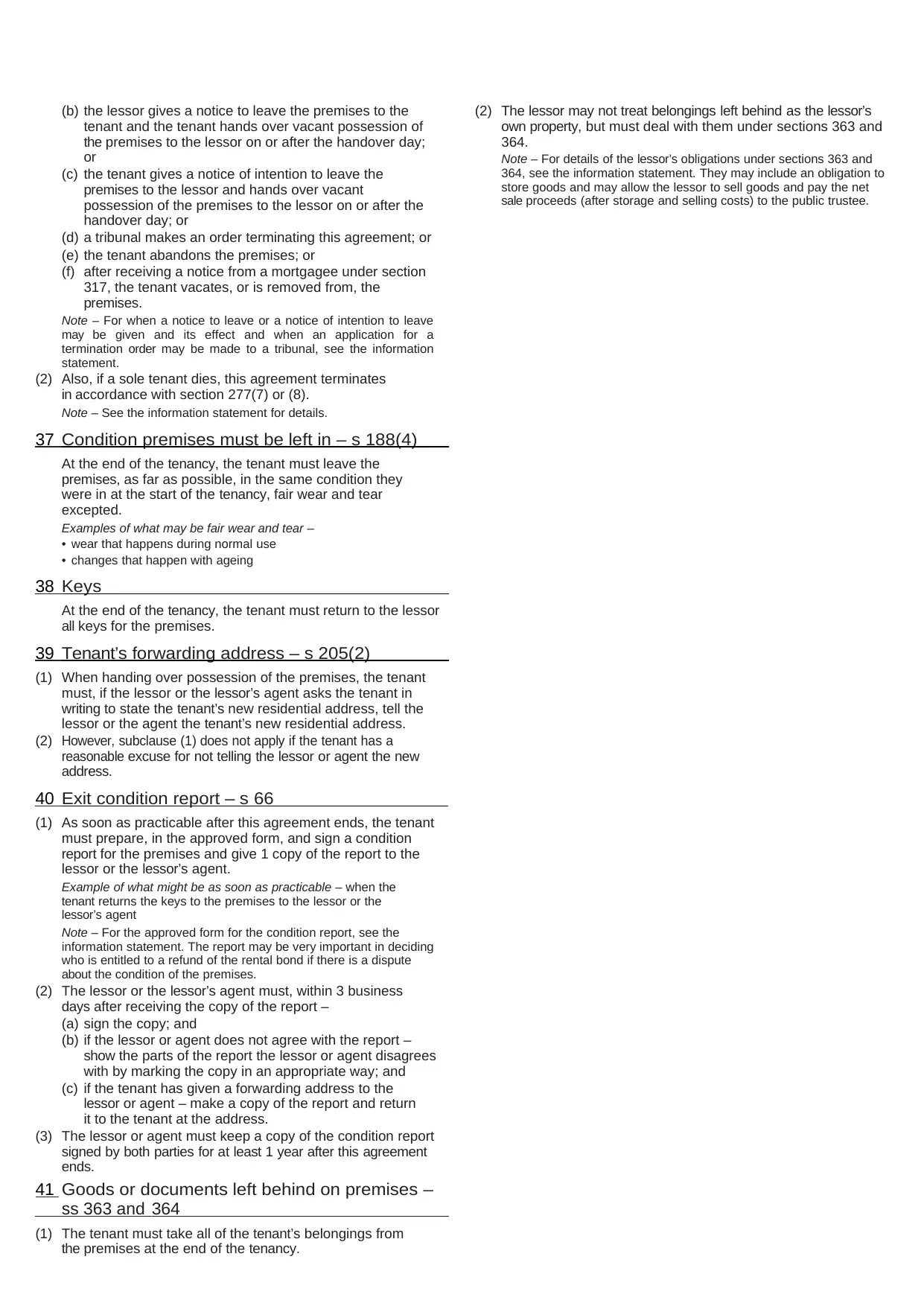
(b) the lessor gives a notice to leave the premises to the
tenant and the tenant hands over vacant possession of
the premises to the lessor on or after the handover day;
or
(c) the tenant gives a notice of intention to leave the
premises to the lessor and hands over vacant
possession of the premises to the lessor on or after the
handover day; or
(d) a tribunal makes an order terminating this agreement; or
(e) the tenant abandons the premises; or
(f) after receiving a notice from a mortgagee under section
317, the tenant vacates, or is removed from, the
premises.
Note – For when a notice to leave or a notice of intention to leave
may be given and its effect and when an application for a
termination order may be made to a tribunal, see the information
statement.
(2) Also, if a sole tenant dies, this agreement terminates
in accordance with section 277(7) or (8).
Note – See the information statement for details.
37 Condition premises must be left in – s 188(4)
At the end of the tenancy, the tenant must leave the
premises, as far as possible, in the same condition they
were in at the start of the tenancy, fair wear and tear
excepted.
Examples of what may be fair wear and tear –
• wear that happens during normal use
• changes that happen with ageing
38 Keys
At the end of the tenancy, the tenant must return to the lessor
all keys for the premises.
39 Tenant’s forwarding address – s 205(2)
(1) When handing over possession of the premises, the tenant
must, if the lessor or the lessor’s agent asks the tenant in
writing to state the tenant’s new residential address, tell the
lessor or the agent the tenant’s new residential address.
(2) However, subclause (1) does not apply if the tenant has a
reasonable excuse for not telling the lessor or agent the new
address.
40 Exit condition report – s 66
(1) As soon as practicable after this agreement ends, the tenant
must prepare, in the approved form, and sign a condition
report for the premises and give 1 copy of the report to the
lessor or the lessor’s agent.
Example of what might be as soon as practicable – when the
tenant returns the keys to the premises to the lessor or the
lessor’s agent
Note – For the approved form for the condition report, see the
information statement. The report may be very important in deciding
who is entitled to a refund of the rental bond if there is a dispute
about the condition of the premises.
(2) The lessor or the lessor’s agent must, within 3 business
days after receiving the copy of the report –
(a) sign the copy; and
(b) if the lessor or agent does not agree with the report –
show the parts of the report the lessor or agent disagrees
with by marking the copy in an appropriate way; and
(c) if the tenant has given a forwarding address to the
lessor or agent – make a copy of the report and return
it to the tenant at the address.
(3) The lessor or agent must keep a copy of the condition report
signed by both parties for at least 1 year after this agreement
ends.
41 Goods or documents left behind on premises –
ss 363 and 364
(1) The tenant must take all of the tenant’s belongings from
the premises at the end of the tenancy.
(2) The lessor may not treat belongings left behind as the lessor’s
own property, but must deal with them under sections 363 and
364.
Note – For details of the lessor’s obligations under sections 363 and
364, see the information statement. They may include an obligation to
store goods and may allow the lessor to sell goods and pay the net
sale proceeds (after storage and selling costs) to the public trustee.
tenant and the tenant hands over vacant possession of
the premises to the lessor on or after the handover day;
or
(c) the tenant gives a notice of intention to leave the
premises to the lessor and hands over vacant
possession of the premises to the lessor on or after the
handover day; or
(d) a tribunal makes an order terminating this agreement; or
(e) the tenant abandons the premises; or
(f) after receiving a notice from a mortgagee under section
317, the tenant vacates, or is removed from, the
premises.
Note – For when a notice to leave or a notice of intention to leave
may be given and its effect and when an application for a
termination order may be made to a tribunal, see the information
statement.
(2) Also, if a sole tenant dies, this agreement terminates
in accordance with section 277(7) or (8).
Note – See the information statement for details.
37 Condition premises must be left in – s 188(4)
At the end of the tenancy, the tenant must leave the
premises, as far as possible, in the same condition they
were in at the start of the tenancy, fair wear and tear
excepted.
Examples of what may be fair wear and tear –
• wear that happens during normal use
• changes that happen with ageing
38 Keys
At the end of the tenancy, the tenant must return to the lessor
all keys for the premises.
39 Tenant’s forwarding address – s 205(2)
(1) When handing over possession of the premises, the tenant
must, if the lessor or the lessor’s agent asks the tenant in
writing to state the tenant’s new residential address, tell the
lessor or the agent the tenant’s new residential address.
(2) However, subclause (1) does not apply if the tenant has a
reasonable excuse for not telling the lessor or agent the new
address.
40 Exit condition report – s 66
(1) As soon as practicable after this agreement ends, the tenant
must prepare, in the approved form, and sign a condition
report for the premises and give 1 copy of the report to the
lessor or the lessor’s agent.
Example of what might be as soon as practicable – when the
tenant returns the keys to the premises to the lessor or the
lessor’s agent
Note – For the approved form for the condition report, see the
information statement. The report may be very important in deciding
who is entitled to a refund of the rental bond if there is a dispute
about the condition of the premises.
(2) The lessor or the lessor’s agent must, within 3 business
days after receiving the copy of the report –
(a) sign the copy; and
(b) if the lessor or agent does not agree with the report –
show the parts of the report the lessor or agent disagrees
with by marking the copy in an appropriate way; and
(c) if the tenant has given a forwarding address to the
lessor or agent – make a copy of the report and return
it to the tenant at the address.
(3) The lessor or agent must keep a copy of the condition report
signed by both parties for at least 1 year after this agreement
ends.
41 Goods or documents left behind on premises –
ss 363 and 364
(1) The tenant must take all of the tenant’s belongings from
the premises at the end of the tenancy.
(2) The lessor may not treat belongings left behind as the lessor’s
own property, but must deal with them under sections 363 and
364.
Note – For details of the lessor’s obligations under sections 363 and
364, see the information statement. They may include an obligation to
store goods and may allow the lessor to sell goods and pay the net
sale proceeds (after storage and selling costs) to the public trustee.
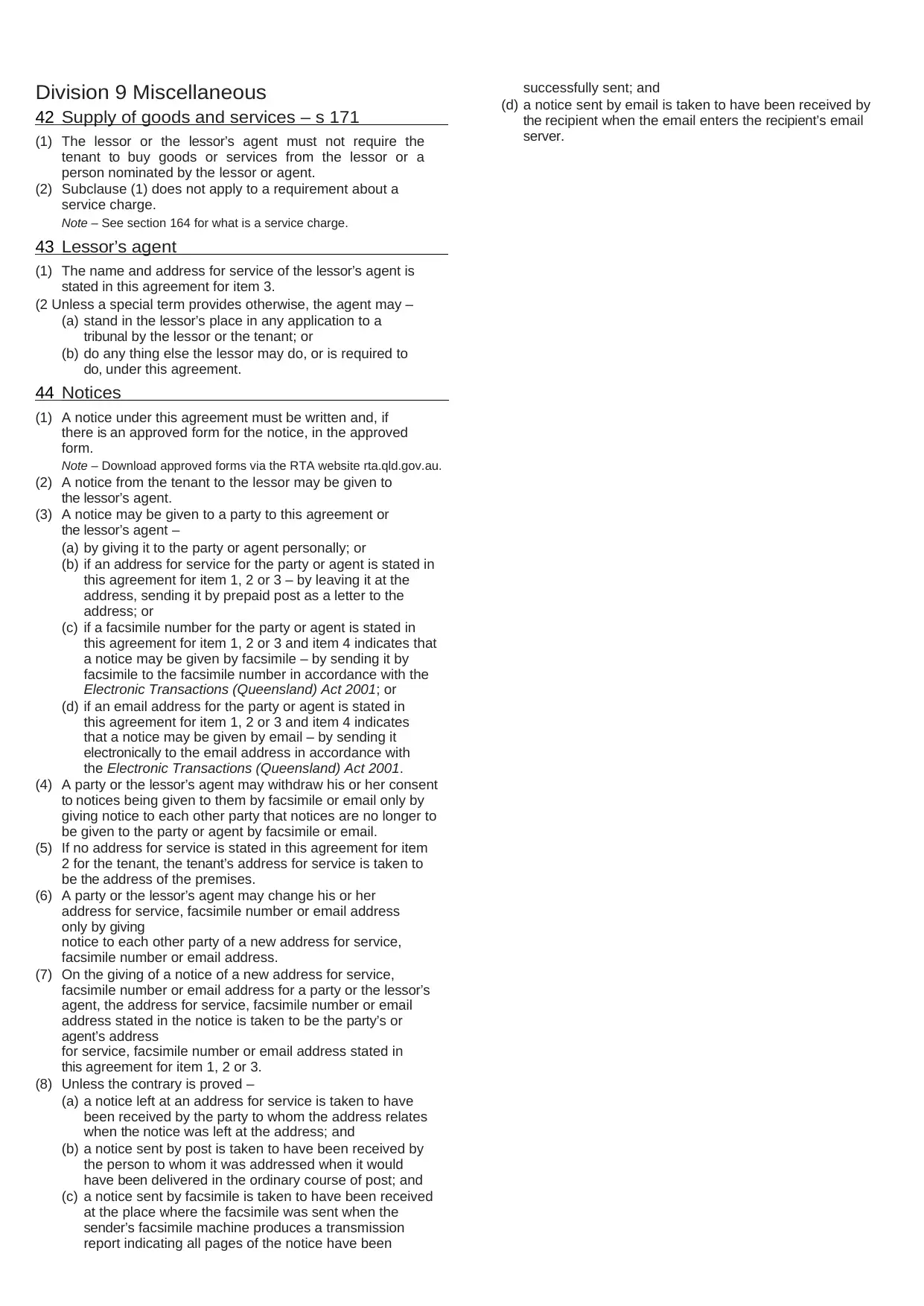
Division 9 Miscellaneous
42 Supply of goods and services – s 171
(1) The lessor or the lessor’s agent must not require the
tenant to buy goods or services from the lessor or a
person nominated by the lessor or agent.
(2) Subclause (1) does not apply to a requirement about a
service charge.
Note – See section 164 for what is a service charge.
43 Lessor’s agent
(1) The name and address for service of the lessor’s agent is
stated in this agreement for item 3.
(2 Unless a special term provides otherwise, the agent may –
(a) stand in the lessor’s place in any application to a
tribunal by the lessor or the tenant; or
(b) do any thing else the lessor may do, or is required to
do, under this agreement.
44 Notices
(1) A notice under this agreement must be written and, if
there is an approved form for the notice, in the approved
form.
Note – Download approved forms via the RTA website rta.qld.gov.au.
(2) A notice from the tenant to the lessor may be given to
the lessor’s agent.
(3) A notice may be given to a party to this agreement or
the lessor’s agent –
(a) by giving it to the party or agent personally; or
(b) if an address for service for the party or agent is stated in
this agreement for item 1, 2 or 3 – by leaving it at the
address, sending it by prepaid post as a letter to the
address; or
(c) if a facsimile number for the party or agent is stated in
this agreement for item 1, 2 or 3 and item 4 indicates that
a notice may be given by facsimile – by sending it by
facsimile to the facsimile number in accordance with the
Electronic Transactions (Queensland) Act 2001; or
(d) if an email address for the party or agent is stated in
this agreement for item 1, 2 or 3 and item 4 indicates
that a notice may be given by email – by sending it
electronically to the email address in accordance with
the Electronic Transactions (Queensland) Act 2001.
(4) A party or the lessor’s agent may withdraw his or her consent
to notices being given to them by facsimile or email only by
giving notice to each other party that notices are no longer to
be given to the party or agent by facsimile or email.
(5) If no address for service is stated in this agreement for item
2 for the tenant, the tenant’s address for service is taken to
be the address of the premises.
(6) A party or the lessor’s agent may change his or her
address for service, facsimile number or email address
only by giving
notice to each other party of a new address for service,
facsimile number or email address.
(7) On the giving of a notice of a new address for service,
facsimile number or email address for a party or the lessor’s
agent, the address for service, facsimile number or email
address stated in the notice is taken to be the party’s or
agent’s address
for service, facsimile number or email address stated in
this agreement for item 1, 2 or 3.
(8) Unless the contrary is proved –
(a) a notice left at an address for service is taken to have
been received by the party to whom the address relates
when the notice was left at the address; and
(b) a notice sent by post is taken to have been received by
the person to whom it was addressed when it would
have been delivered in the ordinary course of post; and
(c) a notice sent by facsimile is taken to have been received
at the place where the facsimile was sent when the
sender’s facsimile machine produces a transmission
report indicating all pages of the notice have been
successfully sent; and
(d) a notice sent by email is taken to have been received by
the recipient when the email enters the recipient’s email
server.
42 Supply of goods and services – s 171
(1) The lessor or the lessor’s agent must not require the
tenant to buy goods or services from the lessor or a
person nominated by the lessor or agent.
(2) Subclause (1) does not apply to a requirement about a
service charge.
Note – See section 164 for what is a service charge.
43 Lessor’s agent
(1) The name and address for service of the lessor’s agent is
stated in this agreement for item 3.
(2 Unless a special term provides otherwise, the agent may –
(a) stand in the lessor’s place in any application to a
tribunal by the lessor or the tenant; or
(b) do any thing else the lessor may do, or is required to
do, under this agreement.
44 Notices
(1) A notice under this agreement must be written and, if
there is an approved form for the notice, in the approved
form.
Note – Download approved forms via the RTA website rta.qld.gov.au.
(2) A notice from the tenant to the lessor may be given to
the lessor’s agent.
(3) A notice may be given to a party to this agreement or
the lessor’s agent –
(a) by giving it to the party or agent personally; or
(b) if an address for service for the party or agent is stated in
this agreement for item 1, 2 or 3 – by leaving it at the
address, sending it by prepaid post as a letter to the
address; or
(c) if a facsimile number for the party or agent is stated in
this agreement for item 1, 2 or 3 and item 4 indicates that
a notice may be given by facsimile – by sending it by
facsimile to the facsimile number in accordance with the
Electronic Transactions (Queensland) Act 2001; or
(d) if an email address for the party or agent is stated in
this agreement for item 1, 2 or 3 and item 4 indicates
that a notice may be given by email – by sending it
electronically to the email address in accordance with
the Electronic Transactions (Queensland) Act 2001.
(4) A party or the lessor’s agent may withdraw his or her consent
to notices being given to them by facsimile or email only by
giving notice to each other party that notices are no longer to
be given to the party or agent by facsimile or email.
(5) If no address for service is stated in this agreement for item
2 for the tenant, the tenant’s address for service is taken to
be the address of the premises.
(6) A party or the lessor’s agent may change his or her
address for service, facsimile number or email address
only by giving
notice to each other party of a new address for service,
facsimile number or email address.
(7) On the giving of a notice of a new address for service,
facsimile number or email address for a party or the lessor’s
agent, the address for service, facsimile number or email
address stated in the notice is taken to be the party’s or
agent’s address
for service, facsimile number or email address stated in
this agreement for item 1, 2 or 3.
(8) Unless the contrary is proved –
(a) a notice left at an address for service is taken to have
been received by the party to whom the address relates
when the notice was left at the address; and
(b) a notice sent by post is taken to have been received by
the person to whom it was addressed when it would
have been delivered in the ordinary course of post; and
(c) a notice sent by facsimile is taken to have been received
at the place where the facsimile was sent when the
sender’s facsimile machine produces a transmission
report indicating all pages of the notice have been
successfully sent; and
(d) a notice sent by email is taken to have been received by
the recipient when the email enters the recipient’s email
server.
Paraphrase This Document
Need a fresh take? Get an instant paraphrase of this document with our AI Paraphraser
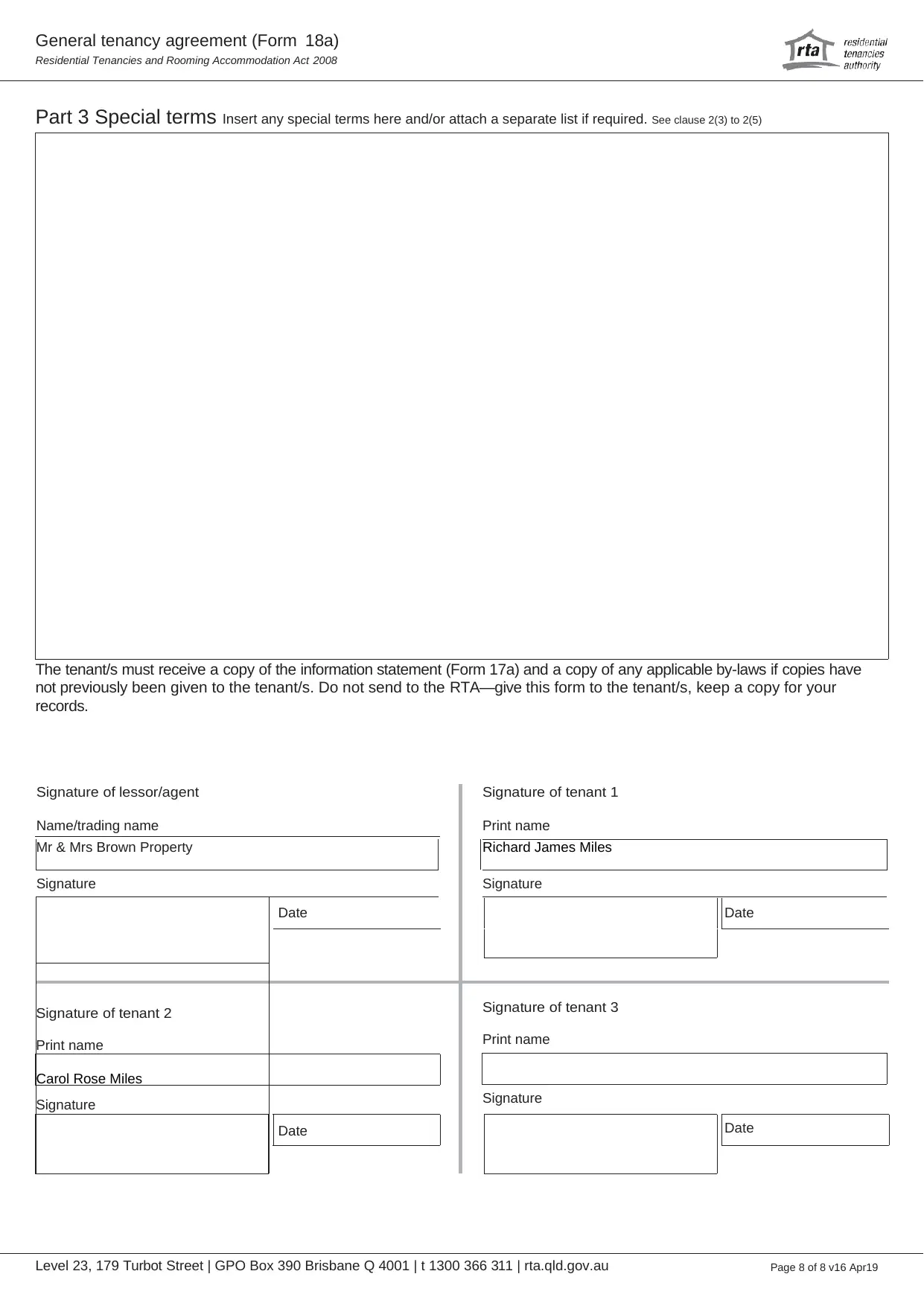
General tenancy agreement (Form 18a)
Residential Tenancies and Rooming Accommodation Act 2008
Part 3 Special terms Insert any special terms here and/or attach a separate list if required. See clause 2(3) to 2(5)
The tenant/s must receive a copy of the information statement (Form 17a) and a copy of any applicable by-laws if copies have
not previously been given to the tenant/s. Do not send to the RTA—give this form to the tenant/s, keep a copy for your
records.
Signature of lessor/agent
Name/trading name
Signature of tenant 1
Print name
Mr & Mrs Brown Property Richard James Miles
Signature Signature
Signature of tenant 2
Print name
Carol Rose Miles
Signature
Date
Date
Date
Signature of tenant 3
Print name
Signature
Date
Level 23, 179 Turbot Street | GPO Box 390 Brisbane Q 4001 | t 1300 366 311 | rta.qld.gov.au Page 8 of 8 v16 Apr19
Residential Tenancies and Rooming Accommodation Act 2008
Part 3 Special terms Insert any special terms here and/or attach a separate list if required. See clause 2(3) to 2(5)
The tenant/s must receive a copy of the information statement (Form 17a) and a copy of any applicable by-laws if copies have
not previously been given to the tenant/s. Do not send to the RTA—give this form to the tenant/s, keep a copy for your
records.
Signature of lessor/agent
Name/trading name
Signature of tenant 1
Print name
Mr & Mrs Brown Property Richard James Miles
Signature Signature
Signature of tenant 2
Print name
Carol Rose Miles
Signature
Date
Date
Date
Signature of tenant 3
Print name
Signature
Date
Level 23, 179 Turbot Street | GPO Box 390 Brisbane Q 4001 | t 1300 366 311 | rta.qld.gov.au Page 8 of 8 v16 Apr19
1 out of 14
Related Documents
Your All-in-One AI-Powered Toolkit for Academic Success.
+13062052269
info@desklib.com
Available 24*7 on WhatsApp / Email
![[object Object]](/_next/static/media/star-bottom.7253800d.svg)
Unlock your academic potential
© 2024 | Zucol Services PVT LTD | All rights reserved.





